How Much Fuel Does a Yacht Use? An In-Depth Analysis
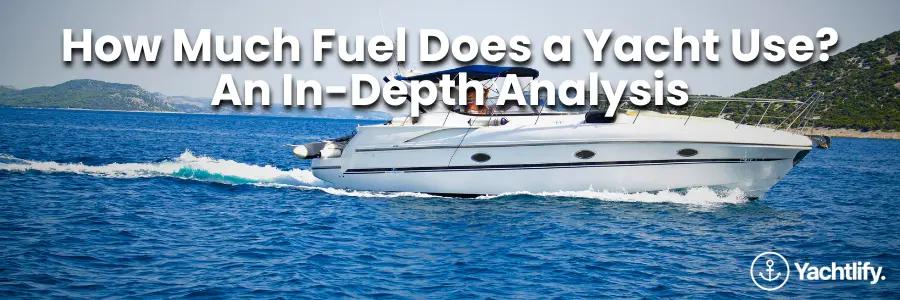
When it comes to luxury and adventure on the high seas, yachts are the epitome of both. Whether you’re a yacht owner or dreaming of chartering one for your next vacation, understanding the fuel consumption of these majestic vessels is crucial. Fuel usage not only impacts the cost of your journey but also has environmental implications. In this article, we dive into the factors affecting yacht fuel consumption and provide insights to help you estimate how much fuel a yacht uses.

Understanding Yacht Fuel Consumption
Fuel consumption in yachts is influenced by several factors, including the yacht’s size, engine type, cruising speed, and conditions at sea. Here, we break down these elements to give you a clearer picture.
Yacht Size and Engine Type
Yachts come in various sizes, from smaller 40-foot models to massive 100-foot plus luxury liners. Generally, the larger the yacht, the more fuel it consumes. Engine type also plays a significant role. Traditional diesel engines are common, but newer models may feature more efficient or hybrid engines that can impact fuel usage.
Cruising Speed
Speed is a significant factor in fuel consumption. Higher speeds increase resistance in the water, requiring more power and, consequently, more fuel. Cruising at a yacht’s optimal speed, often referred to as the “hull speed,” can help maximize fuel efficiency.
Conditions at Sea
Sea conditions can also affect fuel consumption. Smooth, calm waters allow for more efficient travel, while rough seas can increase fuel use due to the additional power needed to maintain speed and stability.
Estimating Yacht Fuel Consumption
While it’s challenging to provide a one-size-fits-all answer due to the variables involved, we can offer some general guidelines. On average, a yacht might use between 20 to 100 gallons of fuel per hour. Smaller yachts, such as those around 40 feet, tend to be on the lower end of the scale, consuming about 20 to 40 gallons per hour. Larger vessels, which are over 100 feet, can consume significantly more, sometimes exceeding 100 gallons per hour, especially at higher speeds.
Example Calculations
Let’s look at an example. For a 70-foot yacht cruising at a moderate speed of 20 knots, fuel consumption could be around 50 gallons per hour. If you’re planning a 100-mile journey, at 20 knots, it would take you approximately 5 hours. This means the total fuel consumption for the trip could be around 250 gallons.
Tips for Reducing Fuel Consumption
- Cruise at Efficient Speeds: Find and maintain your yacht’s hull speed for optimal fuel efficiency.
- Regular Maintenance: Keep the engine and hull in top condition to reduce drag and ensure the engine runs efficiently.
- Plan Your Route: Opt for the most direct route and consider current sea conditions to minimize unnecessary fuel use.
- Lighten Your Load: Only carry what you need for your journey, as extra weight can increase fuel consumption.
Understanding and managing fuel consumption is crucial for any yacht owner or enthusiast. By considering the factors outlined above and implementing fuel-saving strategies, you can enjoy the luxury of yachting more sustainably and cost-effectively. Whether planning a short excursion or a long voyage, a careful consideration of fuel use will enhance your experience on the water.
Remember, every yacht is unique, and so is its fuel consumption. For specific figures, consult your yacht’s manual or speak with a marine professional who can provide insights tailored to your vessel. Enjoy your time at sea, and sail smartly!
Listing your boat with Yachtlify provides several unique benefits, including:
- List once, post on multiple platforms (Yachtlify.com, Facebook Marketplace, Instagram, and others).
- Schedule showings and sea trials with our calendar and reminders.
- View listing engagement analytics across platforms.
- eSign, state forms, and Coast Guard forms to manage closing documentation in once place.
Boat Reviews
- Boats Specs
- Marine Pros
- Boat Insurance
- Boat Warranties
- Boat Transport
- Boat Towing
- Marine Forecasts

Your Ultimate Boating Resource

Calculating Boat Fuel Consumption for Smart Boating
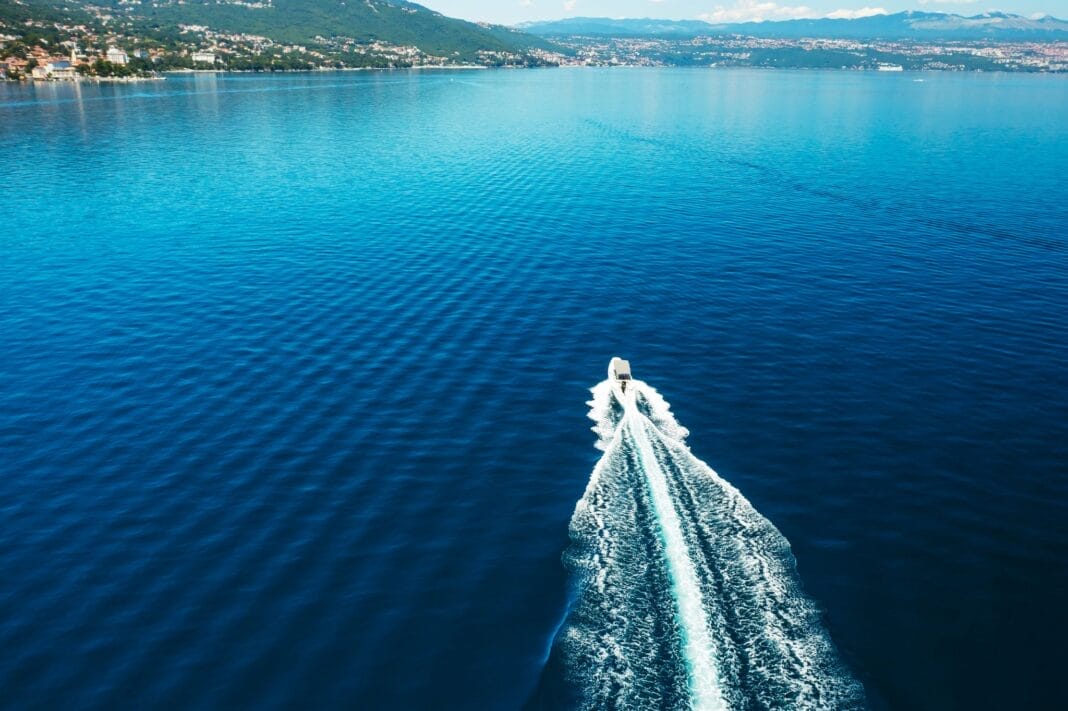
Efficiently managing fuel consumption is a critical skill for boaters, not only affecting the range of your vessel, but also impacting overall expenses. But unlike cars or trucks, calculating a boat’s fuel usage is more complex due to constantly shifting sea conditions.
In this comprehensive guide, we will dive into the intricacies of estimating and computing fuel consumption for boats, empowering you to make informed choices for an optimal boating experience.
Key Points for Fuel Consumption
Determining the amount of fuel your boat consumes holds several significant advantages:
Range Projection
Understanding your boat’s fuel economy–the amount of fuel needed per mile or nautical mile–helps anticipate the safe distance you can cover with a specific fuel capacity.
Cost Analysis
Calculating fuel usage offers valuable insights into operational costs, particularly when comparing different boats or marine engines for purchase.
Comparison Tool
Many boaters rely on fuel consumption charts or use boat tests as benchmarks for comparison. This allows for smarter decision-making when selecting a new boat or engine based on efficiency.
Due to the ever-changing nature of sea conditions, boat fuel efficiency is measured in gallons per hour (GPH). The metric used is pounds of fuel consumed per horsepower generated per hour, commonly referred to as ‘brake-specific fuel consumption.’
Keep in mind that gasoline weighs approximately 6.1 pounds per gallon, while diesel comes in at around 7.2 pounds per gallon.
The relentless hum of a well-tuned four-stroke gasoline engine can consume an impressive 0.50 pounds of fuel per hour for every unit of horsepower it churns out.
And let’s not forget the tireless diesel engine, which burns through 0.4 pounds of fuel per hour for each unit of horsepower it generates.
But be warned, these numbers only scratch the surface–factors like boat drag, sea conditions, and efficiency losses can greatly affect your fuel burn.
To navigate through this maze, use this formula to estimate your boat or engine’s fuel consumption:
GPH = (specific fuel consumption x HP) / Fuel Specific Weight
Gas = 6.1 lb. per gal
Diesel = 7.2 lb. per gal
The key to unlocking maximum horsepower lies in these formulas, optimized for the engine’s peak performance at wide-open throttle. But don’t be fooled–fuel consumption actually decreases during cruising speeds.
And with advanced electronic and direct fuel injection systems, efficiency is taken to a whole new level.
Unlocking Boating Performance
The roar of the boat motor and the number of miles it can go on a single gallon of fuel are crucial elements to consider while out on the water.
These two concepts, known as ‘boat motor pitch’ and ‘miles per gallon (MPG),’ hold the key to unlocking optimal boating performance. So pay attention, because your next adventure may depend on it.
Boat Motor Pitch
The pitch of a boat motor typically refers to the pitch of the boat’s propeller. The propeller pitch is the distance that the propeller would move in one revolution if it were moving through a solid, like a screw through wood. It’s measured in inches.
A higher pitch means the propeller is designed to move the boat further with each revolution, which can be efficient for speed but may reduce the engine’s revolutions per minute (RPM).
A lower pitch propeller will move the boat less distance per revolution but can increase RPM, potentially offering better acceleration and power for carrying heavy loads.
Choosing the right propeller pitch is crucial for optimal boat performance. It needs to be matched with the boat’s size, weight, and the motor’s power to ensure the engine operates within its recommended RPM range for peak efficiency.
Miles Per Gallon
MPG in the context of boats refers to the fuel efficiency of the boat. It indicates how many miles the boat can travel on one gallon of fuel.
Calculating MPG in boats is more complex than in cars due to variable factors like water conditions, boat weight, and hull design. A boat’s MPG can vary significantly based on these factors.
Higher MPG indicates better fuel efficiency, which is desirable for reducing fuel costs and environmental impact.
Boaters often look for ways to improve their MPG by optimizing the boat’s load, maintaining the engine, and using the boat at efficient speeds.
Assessing Fuel Usage and MPG
Begin by filling your boat’s tank to a precise level and recording the gallons added.
Then, set sail and take note of the distance traveled while considering sea conditions and cruising speed.
Upon return to the dock, refill the tank to the same level and record the additional gallons needed.
Using this information, you can determine the amount of fuel consumed during your trip and calculate your MPG using the formula: Distance Traveled / Gallons Consumed.
This equation is a valuable tool for determining the boat’s fuel efficiency and can be used to plan more efficient journeys in the future.
Many modern engines come equipped with gauges that display the total fuel consumption during a trip, as well as real-time updates on fuel efficiency to assist in saving fuel.
Maximizing Fuel Efficiency
The rumble of a boat motor is like a heartbeat to any avid boater. But did you know that how you trim your boat and manage fuel can make or break your entire experience on the water?
These two concepts are key players in maximizing performance and efficiency, leading you to smooth sailing and unforgettable adventures.
Boat Motor Trim
The trim of a boat motor refers to the angle of the outboard motor or stern drive in relation to the transom of the boat. Adjusting the trim changes the angle at which the hull meets the water.
Proper trimming can significantly affect the boat’s performance. When a boat is trimmed correctly, it runs more efficiently, achieving optimal speed and handling. The goal is to find the trim sweet spot where the boat planes smoothly on top of the water with minimal resistance.
Trimming the motor too low (in) causes the bow of the boat to sit lower in the water, increasing drag and reducing speed and efficiency. Trimming too high (out) can cause the propeller to ventilate, leading to loss of propulsion and potential engine damage.
Fuel Economy
Fuel economy in boating refers to how efficiently a boat uses fuel, typically measured in GPH or MPG.
Optimizing the trim of the boat can lead to better fuel economy. When a boat is properly trimmed, it reduces drag and allows the boat to move through the water with less effort and power. This efficiency translates into less fuel consumption for the distance traveled.
Additionally, a well-trimmed boat can also reduce engine strain and potentially extend the life of the motor.
Balancing Trim and Fuel Economy
Achieving the best fuel economy involves finding the optimal trim setting where the boat runs most efficiently. This setting varies depending on the boat’s design, load, water conditions, and speed.
Boaters often use trim tabs or power trim (adjustable with buttons or a lever on the throttle control) to adjust the trim level while underway, constantly fine-tuning for the best performance and fuel efficiency.
It’s important to monitor the boat’s performance indicators such as speed, RPM, and fuel consumption gauge, if available, to determine the most efficient trim setting.
Final Thoughts
Fuel up for success on the open seas by mastering your boat’s fuel consumption and miles per gallon. With this crucial knowledge, boaters can navigate their vessels with confidence and make informed decisions for efficient and cost-effective travels.
Don’t sail blindly–install a fuel monitoring system to track your consumption for ongoing management and worry-free long-distance cruises.
RELATED ARTICLES
Overview of the 2024 sea-doo rxp-x 325, overview of the 2024 parker offshore 2900 cc, what your boat’s beam is and why it matters, power cats of 2024: ultimate guide to the top power catamarans this year, navigating the heat: 10 safety tips for a safe boat ride in the summer heat, latest posts, don't miss, our newsletter.
Get the latest boating tips, fishing resources and featured products in your email from BoatingWorld.com!
What type of wood is used for pier pilings?
What is the difference between a dock and a floating pier, what is the proper technique for pulling a beginner wakeboarder, what does ‘no wake’ mean on a lake, what is the difference between wash and wake, highs, lows, and tidal know-how: a deep dive into ocean currents, 10 essential tips for fishing near private property, the benefits of using a drift sock: guidance for anglers, lure fishing: secrets for imitating live bait and attracting fish, explore the untapped depths of america’s best bass fishing spots, outboard motor maintenance: tips for keeping your engine in top shape, the essential boat tool kit: tools every boater needs, diy boat building: 8 tips and tricks for building your own vessel, the art of miniature maritime craftsmanship: ship in a bottle, antifouling paints: a guide to keeping your boat shipshape, beginner’s guide to standup paddle boarding: tips and techniques, boating for fitness: how to stay active on the water, kayak safety: how to stay safe on the water, anchoring in a kayak or canoe: how to secure your small boat, overview of the 2024 yamaha 252sd, overview of the 2024 tiara yachts 48 le, overview of the 2024 bass cat jaguar sts, 2024 pursuit os 445: an overview, 2024 aquila 47 molokai review, 2024 sea-doo switch 13 sport review, gear reviews, megabass oneten max lbo jerkbait review, fortress anchors fx-7 anchoring system review, fortress anchors fx-11 anchoring system review, fortress anchors commando anchor kit review, fortress anchors aluminum anchors review, stay in touch.
To be updated with all the latest news, offers and special announcements.
- Privacy Policy

- Charter & Brokerage
- Yacht Design & New Builds
- Tenders & Toys
- Superyacht Events Calendar
- Career & Training
- Departments
- Superyacht Crew Finances
- Sustainability
- Shipyards and Marinas
- Health & Wellbeing
- Polar Region
- Our Services
- Meet the Team
Yachts And Fuel – How Much Do They Really Consume?
.png)
Fuel is one of many annual running costs of a yacht. Not only does the yacht need fuel for cruising; the generators require it to keep the vessel running while at anchor and underway. As well as this, many of the water sports toys require it too.
Some yachts cross the Atlantic Ocean twice a year between the Mediterranean and Caribbean while others embark on world cruises. That equates to a lot of fuel.
So How Much Do They Really Consume?
According to the Yachting Pages, the longest Superyacht in the world, 180m M/Y Azzam, holds 1,000,000 litres of fuel. To put it into perspective, that is the equivalent of filling a regular hatchback car 23,800 times. Or, six Boeing 747 commercial airliners.
West Nautical’s Vessel Manager, Tony Hildrew, a former Yacht Chief Engineer said:
“Fuel is the single biggest expense when it comes to yacht operations, it is estimated that the global spend on fuel is around $150bn annually however this shouldn’t put you off, there are a number of ways to ensure your fuel consumption doesn’t get out of hand. Implementing a Ships Energy Efficiency Management Plan or SEEMP for short is a great way to keep fuel costs down without compromising on your cruising experience.”
Each yacht will consume fuel differently for a number of reasons. It could be the size and make of the engines. Or, how often the yacht is using generators. As well as the number of tenders and water sports toys on board that require fuel. For example, if the yacht is out at anchor and running on generators 90% of the time, the fuel consumption will be much higher than a yacht that is in a marina at night and connected to shore power and water.
Another factor that will affect fuel consumption is the yacht’s itinerary. This is because the sea conditions will impact how much fuel the engines consume.
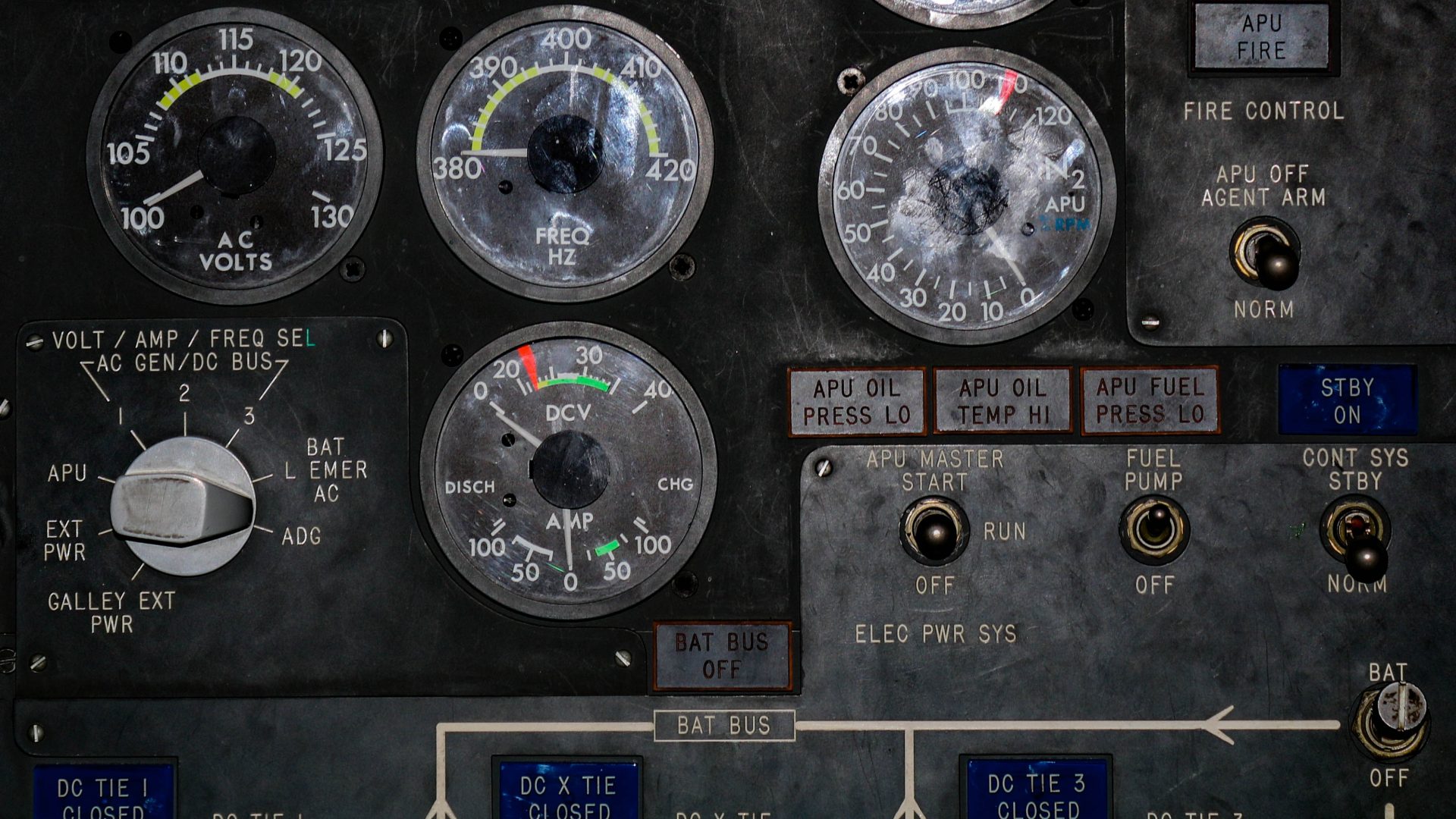
How Is Consumption Measured?
You will be able to input the start and ending points of your cruise on the map. This will automatically update the distance table. The next step is to enter the speed, fuel consumption and cost of fuel per litre to determine the cost of the trip.
Here is an example: A fast 30m yacht cruising at 20 knots will consume roughly 400 – 500 litres depending on the engine type. This would equate to the total consumption of 2500 litres for a distance of 100 nautical miles.
Another example is, a 70m yacht looking to travel 100 nautical miles with the engines burning 1000 litres per hour would add up to a total consumption of 8335L for that passage. Depending on where the yacht bunkered, the estimated cost with the price per litre being on the low end at €0.90 per litre would cost a total of €7501.50. An example of a 100 nautical mile passage would take you from Saint Tropez to The North Coast of Corsica.
How Much Does It Cost?
Fuel prices fluctuate depending on which country you bunker in and some places you bunker offer tax free fuel such a Gibraltar and Montenegro. Fuel prices can vary but typically costs between €0.80 and €1.30 per litre.
Yacht charter, sales and management company West Nautical added:
“Fuel costs should be at the top of any yacht owner and captain’s minds for two reasons: to minimise costs as well as reduce the environmental impact of burning unnecessary fuel. The superyacht charter market, more than most other markets, relies on pristine waters for their guests to enjoy their holiday. If the oceans in popular charter destinations are not maintained, it will decrease the demand for yacht charter and therefore the revenue for owners.” “If you are looking for expertise in operational management and engineering in order to plan a SEEMP, West Nautical would be delighted to assist.”
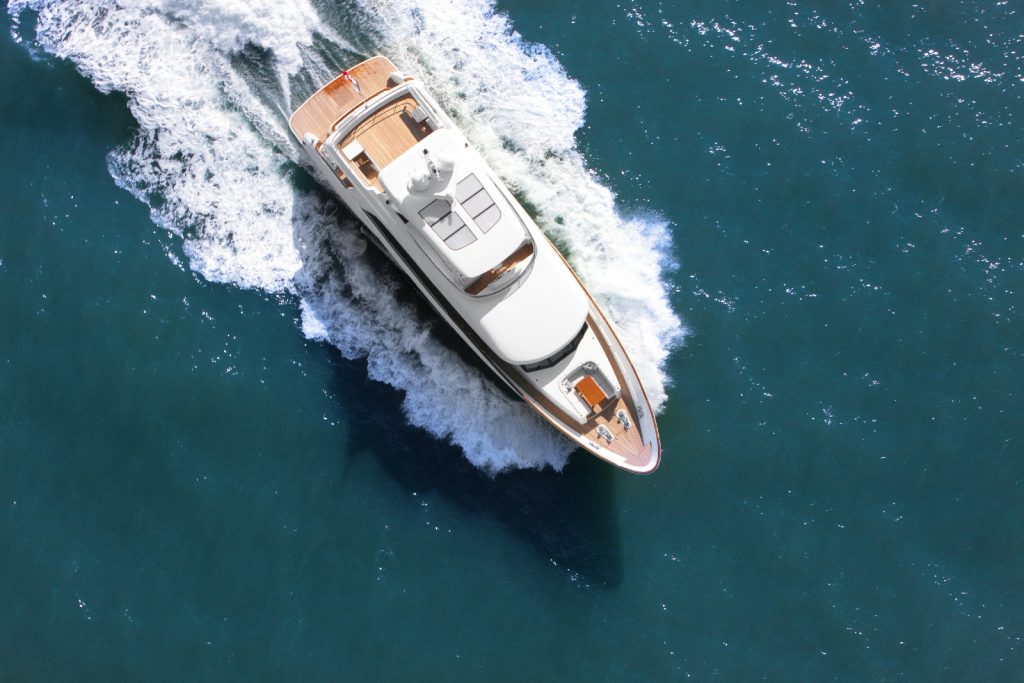
About West Nautical
West Nautical sell, charter and manage superyachts from their head office in Newcastle upon Tyne. The business currently employs a team of 21 staff throughout their offices based in the UK, Russia, France and Cyprus.
Since their inception over 25 years ago, West Nautical have become recognised as one of the most respected, trusted, knowledgeable and accountable professional services firms in yachting – largely due to their relentless determination to act in our clients’ best interests. Their approach and attitude is transparent, refreshing and focused on providing value-added services delivered simply, elegantly and affordably.
Visit West Nautical’s website here: https://westnautical.com
For Media enquiries please contact sarah.mackenzie@westnautical.com
To keep up to date with the latest Superyacht Content News, click here .
Sign up to our Newsletter below:
Newsletter Signup
- Your Name First Last
- Your Email *

West Nautical
Related articles, lithium-ion battery safety on superyachts & the urgent need for industry awareness, know your ship how helideck pop-up foam firefighting systems work, scorpion tenders from twisted marine. setting world class standards, navigating busy season: crew wellness tips with superyacht fitness & emma from seas the mind.

Superyacht Content
Social media influencer and digital brand expert.
Superyacht Content brings you the latest in social news for the superyacht industry.
Keep up to date with us across our social channels, and don’t forget to hit that share button!
- Superyacht News
- Superyacht Jobs
- Superyacht Marketing
Join our Newsletter
Copyright © 2023 Superyacht Content | Website Design by Zonkey
Privacy | Credits | Get in Touch
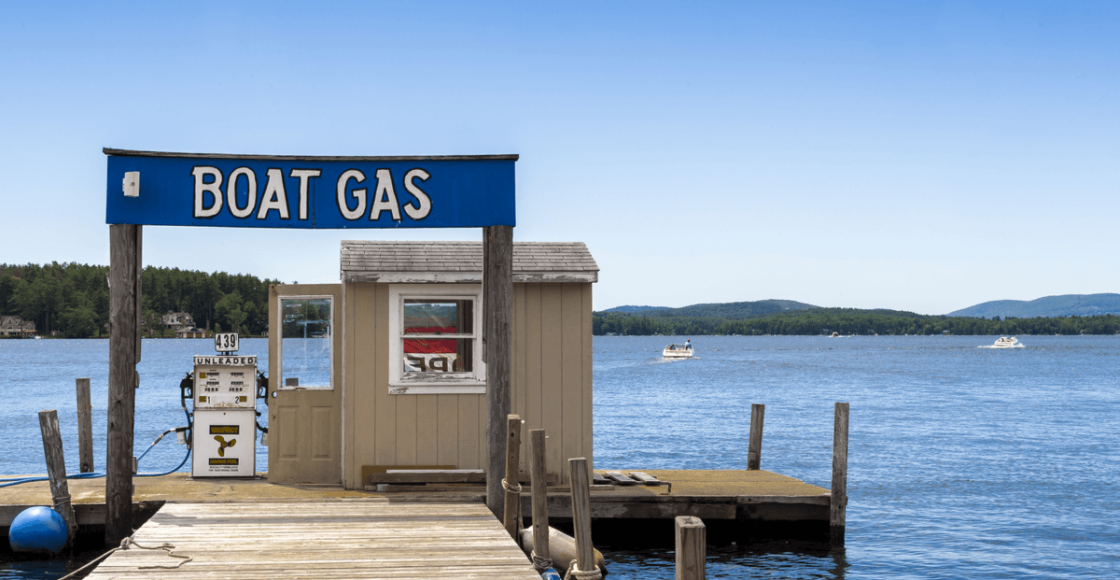
Boat Fuel Consumption: 5 Tips for Measurement, Efficiency, and Savings

Table of Contents
Last Updated on November 3, 2023 by Boatsetter Team
Boat fuel consumption can be a rather significant expense , and it’s one that goes up as gas prices rise. While it’s true that you have to pay to play, there are some measures boaters can take to cut down on this expense as the price of gas goes up.
Here are five tips to help save money on marine fuel for your boat:
- Lighten your load by removing excess gear and weight.
- When operating, bring the boat on plane, then leave the throttle alone.
- Understand how to properly trim your boat—if the bow seems high, trim it down.
- Ensure your boat’s propeller is the right size, material, and model to maximize performance.
- Keep the bottom of your boat’s hull clean and smooth.
Read on for further details and instructions on implementing each of these five tips, and be sure to use a boat fuel consumption chart to understand your engine’s ideal fuel economy.
Own a Boat? Learn How to Offset the Cost of Ownership by Listing on Boatsetter
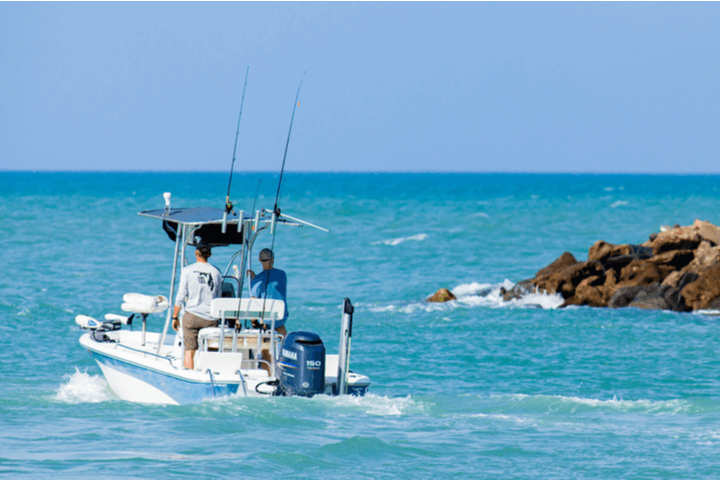
1. Lighten the Load
Many boats get loaded down over time without anyone even noticing, and the heavier your boat is, the less efficient it will be. While some gear is absolutely necessary, some other stuff may not be — and when added up it can weigh a ton.
- Think about removing that extra anchor rode, the big box of fishing weights, dishware that never gets used, and similar items from the boat.
- Also consider the water and waste tanks, if your boat has them. Can you get by with a half-full water tank? If so, you’ll shed eight pounds per gallon. W
- When is the last time you pumped out the waste tank? Again, you can remove a lot of weight from the boat by lowering its level.
2. Bring the Boat on Plane, then Leave the Throttle Alone
As is true with cars, boats tend to burn less gas at slower speeds. Boats are different, however, in that most get the worst fuel economy just below planning speed and the best economy just above it.
There are certainly some exceptions (such as some trawlers and some boats propped to go very fast) but as a general rule, the average outboard powerboat will break onto plane right around 3000 to 3500 RPM. And in most cases, this is where they get the best cruising fuel economy.
Note that on newer board your MPG may be displayed on a gauge at the helm . In this case, simply eyeball that gauge and you can see just when the boat’s getting its peak mileage.
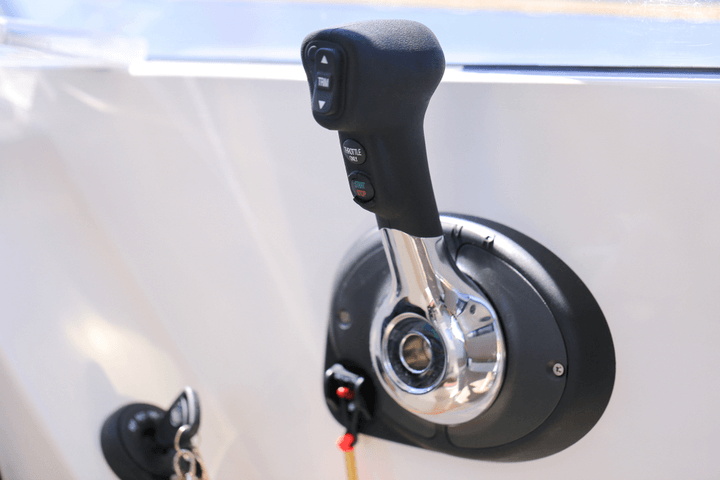
3. Tweak the Trim
Most boats run best on an even keel at a slight inclination of just two to four degrees. But depending on the boat’s design and the weight distribution of gear and passengers, you may need to adjust engine or drive trim and/or trim tabs to get it running this way.
If the bow seems to dig in try trimming the bow up a bit, and if you have to crane your neck to see over the bow, trim the bow down some.
4. Make Sure You Have the Right Propeller
Few boaters ever change propellers to see if they can gain a performance edge, but doing so can add several MPH to your cruising speed, which equates to more miles traveled for less gas burned .
Finding the ideal prop for your boat may take some experimentation; remember that your goal is to turn wide-open RPM in the middle of the manufacturer’s recommended range, and adding an inch of pitch will decrease rpm by about 200, while dropping by an inch will increase RPM by about the same amount.
Also note that switching from an aluminum propeller to a stainless-steel model can gain you one to three MPH, as well.
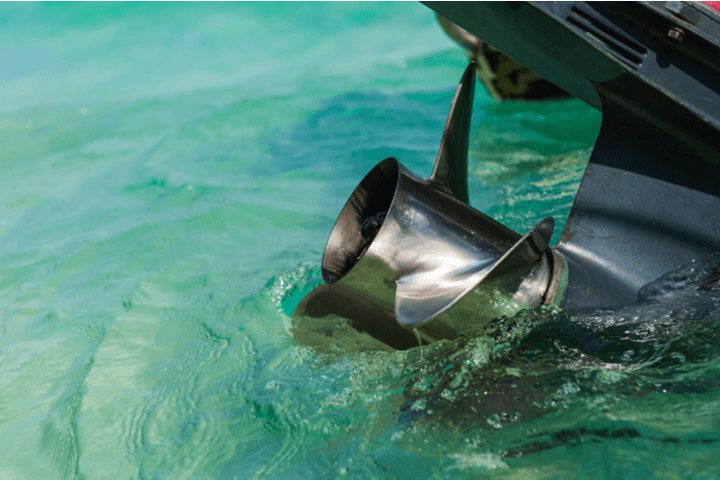
5. Keep the Bottom of Your Boat Clean
Few things sap speed and increase fuel consumption like a dirty bottom. While antifouling paint will keep most of it at bay, its effectiveness can drop with age. Plus, even a freshly-painted boat can develop a layer of scum or slime, and many boats have unpainted underwater surfaces like transducers that growth can adhere to.
- So, if your boat lives in a wet slip it’s a good idea to pull up to a sandbar or beach once in a while and gently scrub the bottom.
- If there are any areas where more substantial growth has attached, scrape them clean with a rigid object that won’t damage the surfaces, like a plastic putty knife.
Employ all of these tips, and your boat may burn one, five, or even 10 gallons less fuel on your very next trip. Every boat will be different, of course, but no matter how large or small it may be, at today’s gas prices those saved gallons can add up to some serious cash in the bank.
Earn an Average of $20,000 or More by Listing Your Boat for Rent on Boatsetter

With over three decades of experience in marine journalism, Lenny Rudow has contributed to dozens of boating and fishing publications and websites ranging from BoatU.S. Magazine to BDOutdoors.com. Rudow is currently the Angler in Chief at Rudow’s FishTalk , he is a past president of Boating Writers International (BWI), a graduate of the Westlawn School of Yacht Design, and has won numerous BWI and OWAA writing awards.
Browse by experience

Explore articles
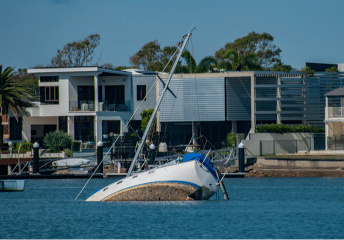
What Should You Do If Your Boat Capsizes

Best fishing spots in Massachusetts
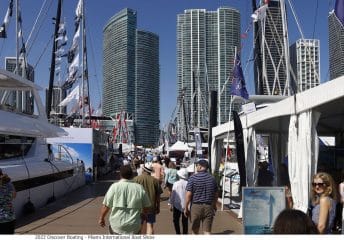
Discover Boating Miami International Boat Show 2023 Preview

7 Best Boating Safety Tips for Summer Fun

Do you operate a yacht? Our app is perfect for you
Yacht fuel cost calculator - how to estimate the costs.
Yacht captains have many responsibilities when it comes to the management of their vessel. One of them is keeping track of expenses, which is why it is important to familiarize yourself with the vessel’s operational costs. Keeping a luxury superyacht afloat isn’t cheap, and many claim that the average annual cost ranks up to 10% of the vessel’s price.
From these expenses, a significant portion goes to fuel. Filling up the tank of your boat is quite pricey, which is why a growing number of boat owners want to know exactly how much they are looking to spend for their upcoming voyage. This is also important for people who want to charter a boat for their holiday.
If you’re wondering how to best estimate the costs involved, you’re in the right place. This article will help you calculate your vessel’s yacht fuel cost while giving an overview of all the criteria used as variables. To make the process even easier, we link to a yacht fuel cost calculator to help you get an indication of the expenses you’ll need to cover. Let’s delve in!
Yacht fuel cost calculator
How to estimate yacht fuel costs, how much fuel does a yacht use.
- Price of boat fuel per gallon?
Yacht fuel formula
The easiest way to calculate your fuel costs is by using a yacht fuel cost calculator. There is a great calculator available here in case you want to save time and get an approximate estimation.

As you can see, the yacht fuel cost calculator has many variables which you need to be aware of before you set out to calculate the approximate price. This is what we will be dealing with in the next few chapters.
To help you get a better understanding of the calculation process we will do things manually while giving you the exact formulas used to calculate your vessel’s fuel needs. Therefore, make sure you keep on reading.
There are several things you need to keep in mind when you first set out to estimate the total fuel cost for your next voyage. These are summarised in the following points:
- Distance of journey - The total amount of nautical miles (or km)
- Cruising speed - The (average) speed of your vessel (in knots or km/hr)
- Fuel consumption - Understanding how many gallons (or liters) of fuel are consumed per hour
- Yacht fuel price - Understanding the average market price per gallon of fuel
The first two points depend solely on your needs and personal preference, which means that they are more flexible on a subjective basis. The latter two points may require a bit of research, especially if you’re not familiar with the engine of the vessel.
In the following sections, we will delve deeper into each of the points mentioned above, and offer the required formulas to help you calculate yacht fuel cost.
Calculating distance and speed
To understand the exact distance you are looking to cover in your next voyage, you can simply use Google Maps to plan your route. The following video explains the process in detail.
As soon as your route is planned out, you can measure the distance as well, selecting the preferred method of calculation. In our case, it is best to measure in nautical miles (1nm=1,85km), as this metric is more commonly used among sea men. The yacht fuel cost calculator above has an embedded map that helps you pinpoint the journey you want to make.
Next comes the cruising speed. The number is mostly calculated in knots (nautical miles/hr). The speed with which the vessel will cruise depends on the captain onboard, but is often influenced by the owner and guests onboard. You can make a rough estimation of this number based on previous trips.
Next, we need to calculate the amount of fuel that you will likely need. To do this we need to understand the engine type, its horsepower, and several other factors.
Let’s take a marine diesel engine for example. These engines are very common on motor yachts and consume approximately 0.4 pounds of fuel per hour for each unit of horsepower. You can find fuel consumption info for your specific engine by looking it up on the web or by calling the service number.
Once you know the fuel burn rate, it’s best to add a relative error margin of 10% based on minor factors. These include weather conditions, vessel size, and drag, all of which can increase the fuel burn.
How much fuel does a yacht use per hour?
Now that you know all the variables you can go ahead and calculate the amount of fuel that your yacht will need.
- Start by calculating the fuel burn per hour based on the horsepower of the engine.
- Add a multiplier based on the cruising speed of your vessel.
A vessel with a diesel engine of 300 horsepower will most likely burn 16-17 gallons per hour, which you can then use as a guideline when calculating the travel time based on the nautical miles you are looking to cover.
Superyachts are consuming much more fuel. An average 70-meter luxury yacht will burn around 130 gallons per hour with the engines running, while the amount increases significantly when the ship is moving. On average, you are looking at ±€2000 per hour (±1000 gallons) to achieve a speed of 20 knots. Of course, the higher the cruising speed, the more fuel you will be burning per hour, which in turn makes each hour at sea more expensive.
How much does boat fuel cost per gallon?

The exact price you are looking to pay per gallon depends on the marina you find yourself in. By looking at several price points of marinas, we get the following:
- Average diesel prices range from $3.2-$3.9 per gallon
- Average petrol prices range from $7.2-$7.8 per gallon
Note that discounts usually apply whenever you choose to purchase large quantities of fuel.
Why is boat fuel so expensive?
Marine fuel pricing is heavily inflated due to low supply and high demand. In short, the limited number of fuel stations at marinas have to service all the yachts that dock, which leads to a no-choice monopoly.
That said, yacht owners are usually not that concerned about the small price spike that marinas charge as an extra. If anything, they are happy to pay due to the convenience of the service.
How much fuel does a yacht hold?
Once again, the answer to this question depends on the size of the vessel. Smaller yachts can hold around 1300 gallons of fuel, while the bigger vessels can store up to 100,000 gallons. The ship’s engineers should be able to provide this number for the vessel you command.
Now that we have a better understanding of all the variables that determine the cost of fuel, we can go ahead and take you through the calculation process step by step.
First, know the total duration of your cruise. To obtain this information, divide the number of nautical miles by the cruising speed of your vessel (knots). For example, if you want to make a journey that totals 150 nautical miles while traveling at 20 knots, the yacht fuel formula looks as follows:
Total duration = 150 nm / 20kn
Total duration = 7,5 hrs
Note that the amount of fuel consumption may end up higher than expected if:
- Sea and weather conditions are not favourable
- You plan to make short stops along the way while the engine keeps running
Next, what you want to do multiply the number of hours by the number of gallons that your engine burns on an hourly basis while moving at the speed you previously indicated. If we take, as an example, the superyacht mentioned in the previous examples, we would make the calculation as follows:
7,5 hrs x 1000 gph = 7500 gallons
Now assume that you will also make two stops along the way, an hour and a half each, in order to let the guests enjoy their time; maybe ride a jet ski.
You then multiply the added number of hours with the consumption rate of a running engine. In this case:
3 hrs x 130 gph = 390 gallons
All that is left to do now is add up the total amount of fuel needed and multiply the number with the price per gallon.
(7500+390) x $3,5 = $27615
In this example, the final cost of your will set you back a little bit more than 27 thousand dollars. Just to be safe, calculate the additional 10% (margin of error) to be prepared against unexpected mistakes. This added amount is not necessarily an ad-on when you consider chartering. Private yacht owners, however, should add the amount to their final cost.
And that's it! You should now have a better idea on the steps you need to follow to calculate the fuel costs for your yacht. While there is quite a bit of information you should keep in mind, it is best to plan out everything with detail to avoid unforeseen costs. If you enjoyed this article, check out our blog post on yacht electrical systems as well.

- 2024 BOAT BUYERS GUIDE
- Email Newsletters
- Boat of the Year
- 2024 Freshwater Boat and Gear Buyers Guide
- 2024 Boat Buyers Guide
- 2024 Water Sports Boat Buyers Guide
- 2024 Pontoon Boat Buyers Guide
- Cruising Boats
- Pontoon Boats
- Fishing Boats
- Personal Watercraft
- Water Sports
- Boat Walkthroughs
- What To Look For
- Watersports Favorites Spring 2022
- Boating Lab
- Boating Safety
- Ultimate Boating Giveaway

Calculating Boat Fuel Consumption
- By Brett Becker
- Updated: September 30, 2019
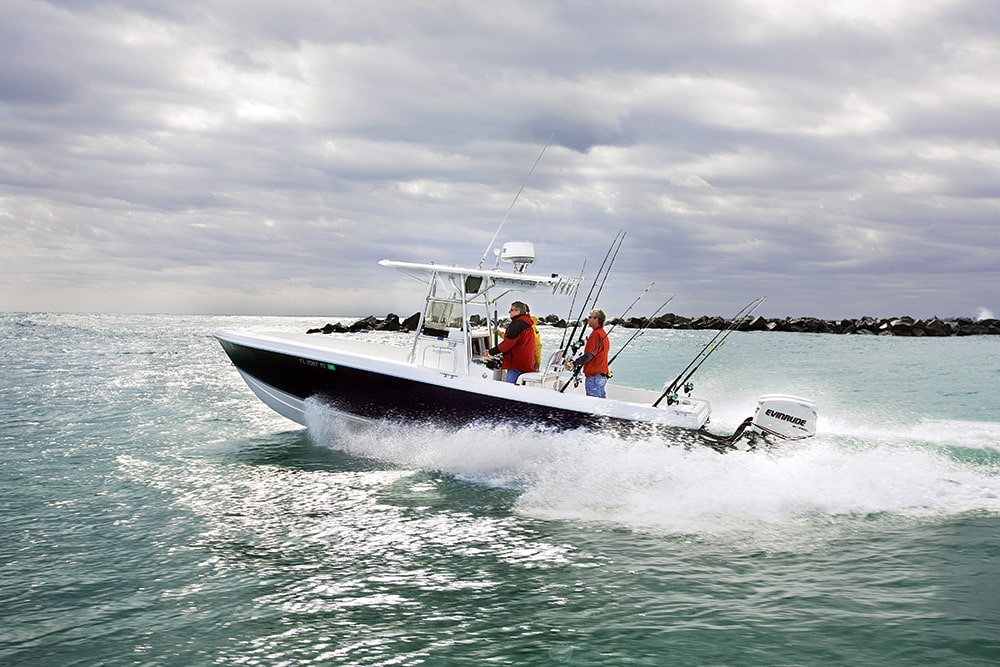
Calculating a boats fuel consumption proves important to boaters for number of reasons. With knowledge of a boat’s fuel economy-how much fuel the boat burns per mile or nautical mile of travel-boaters can estimate the range they can safely expect to run.
Some boaters go as far as to develop a boat fuel consumption chart for their boat. You can use any Boating boat test as a model for this. Of course, you can also install a fuel consumption monitor if your boat’s engine does not provide a fuel consumption readout.
Additionally, knowing your boat’s fuel consumption provides a good idea of how much it will cost you to operate the boat. When shopping for a new boat or marine engine, fuel consumption provides a major basis of comparison.
Estimating Your Boat’s Fuel Burn
It’s a different story with a boat. Since sea conditions vary more widely than road conditions, the time it takes to cover a distance varies more, so fuel consumption is measured in gallons per hour. Also, while many engines have fuel flow readouts , the ability to estimate fuel burn while shopping for a boat or engine is important. You measure fuel efficiency in pounds of fuel used per horsepower developed per hour. The pros call it “brake-specific fuel consumption.” This makes it important to know that gasoline weighs about 6.1 pounds per gallon and diesel fuel 7.2 pounds per gallon.
On average, an in-tune four-stroke gasoline engine will burn about 0.50 pounds of fuel per hour for each unit of horsepower. Likewise, a well-maintained diesel engine burns about 0.4 pounds of fuel per hour for each unit of horsepower it produces. These figures don’t take drag of the boat, sea conditions, or efficiency losses through transmissions and bearings into account. But they provide an excellent relative difference between engines when shopping.
Confused yet? Look at the mathematical examples below, and a boat’s fuel economy should become clear.
Boat Fuel Consumption Formulas and Calculator
Below is the Formula to Estimate Maximum Engine Fuel Consumption.
GPH = (specific fuel consumption x HP)/Fuel Specific Weight
Constants | Gas | Diesel SFC: .50 lb. per HP | .40 lb. per HP FSW: 6.1 lb. per gal. | 7.2 lb per gal.
300-hp Diesel Engine Example GPH = (0.4 x 300)/ 7.2 = 120/7.2 = 16.6 GPH
300-hp Gasoline Engine Example GPH = (0.50 x 300)/ 6.1 = 150/6.1 = 24.5 GPH
Keep in mind that these formulas apply when the engine is making peak horsepower, which usually is near wide-open throttle. Fuel consumption will be decreased at cruising speeds. Also remember that engines with electronically-managed fuel injection and direct injection will yield higher fuel efficiency .
To apply these formulas to your boat, just plug in its horsepower rating and multiply it by the specific fuel consumption average, then divide the product by the fuel specific weight.
Another way is to take the total engine horsepower and divide it by 10 for gas engines or .06 for diesel engines. As you can see, this formula is simpler to calculate and easier to remember. You don’t even need a pencil and paper. It’s just not as accurate as the formulas above. The result represents the approximate gallons per hour the engine will burn at wide-open throttle. For example, a 150-horse engine will use about 15 gallons per hour. Though these figures represent averages and can vary from 10 to 20 percent, they’ll put you in the ballpark so you can plan a long-distance cruise without fear of running out of gas . You can also keep track of your boat’s fuel consumption by installing a fuel monitor.
- More: Engines , fuel consumption , How-To
More How To

On Board With: Monique Richter
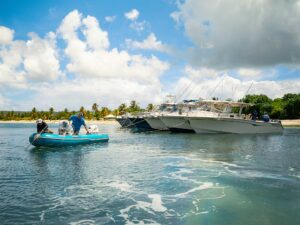
Grady-White Pulls off Its Largest Raft-up Ever in Vieques, Puerto Rico
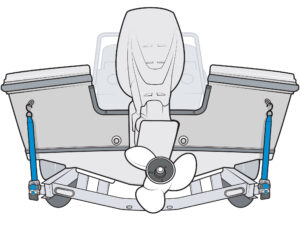
Installing Retractable Transom Straps
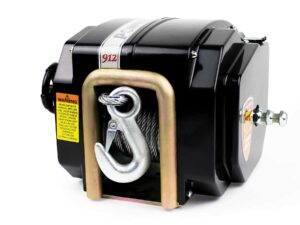
How to Choose a Trailer Winch
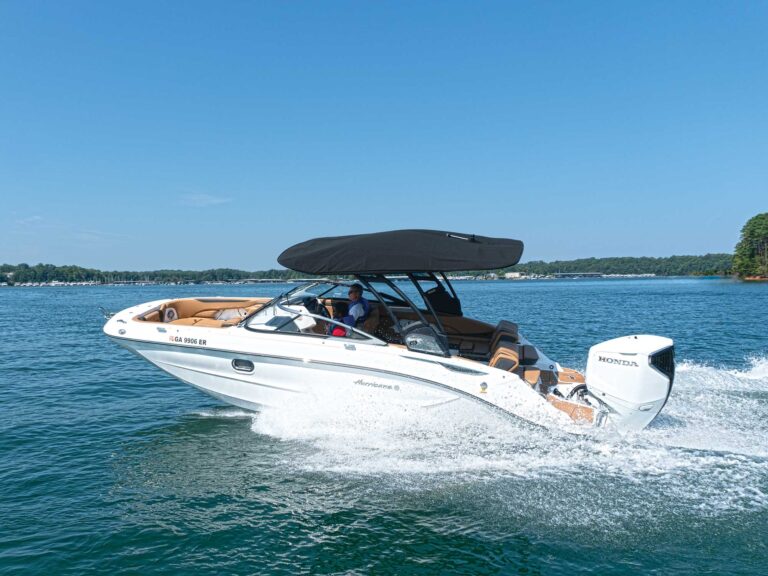
Boat Test: 2024 Hurricane SunDeck 2600 OB
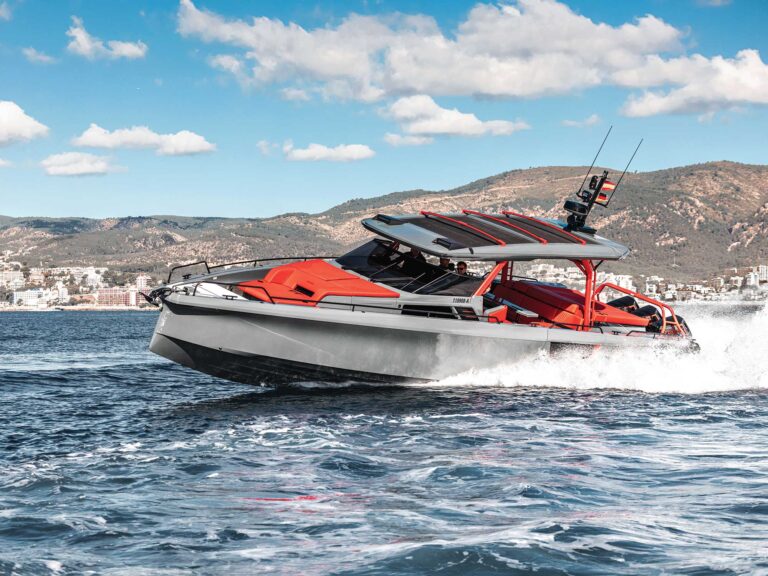
Boat Test: 2024 Brabus Shadow 1200 Sun-Top
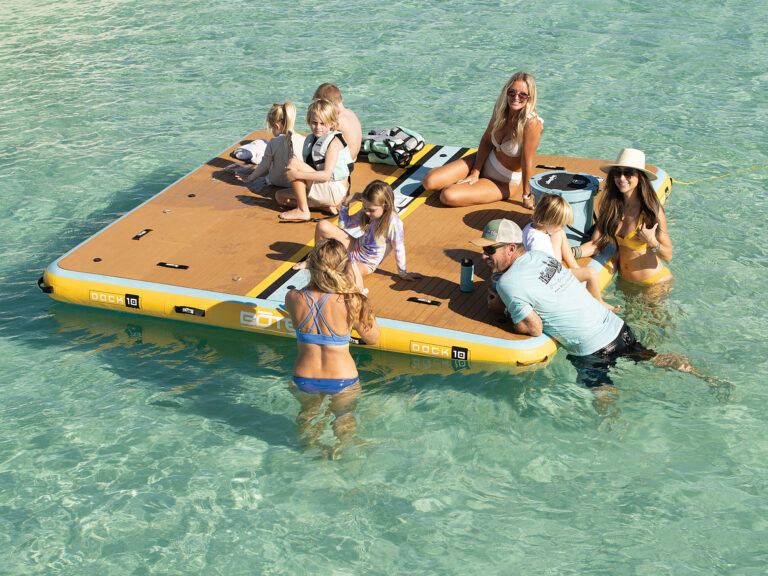
Inflatable Water Mats for Boaters
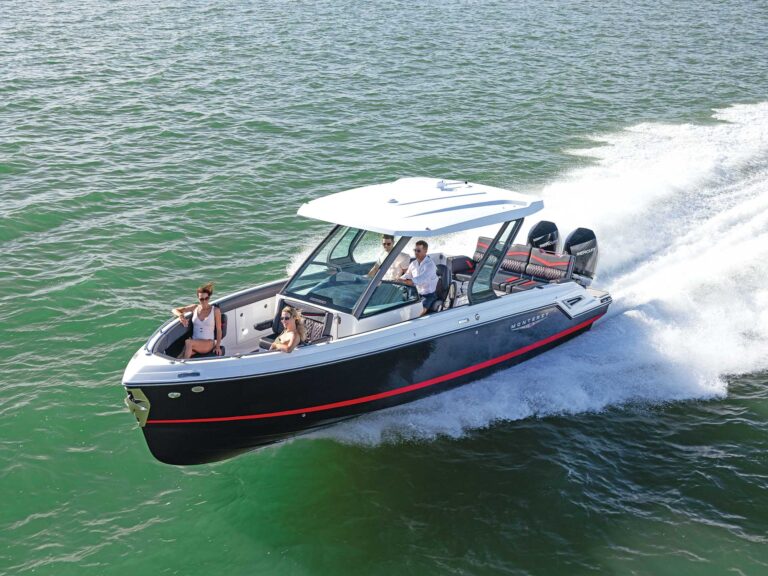

Boat Test: 2024 Monterey Elite 30

- Digital Edition
- Customer Service
- Privacy Policy
- Terms of Use
- Cruising World
- Sailing World
- Salt Water Sportsman
- Sport Fishing
- Wakeboarding
Many products featured on this site were editorially chosen. Boating may receive financial compensation for products purchased through this site.
Copyright © 2024 Boating Firecrown . All rights reserved. Reproduction in whole or in part without permission is prohibited.

- Center Consoles
- Dual Consoles
- Motoryachts
- Sport Cruisers
- Tenders & Ribs
- U.S. Atlantic
- Engine Buyers Guide
- Electronics
- Digital Edition
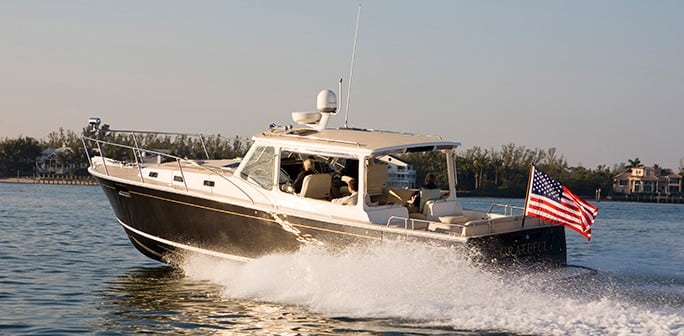
The MJM Yachts 40z cruising along, powered by Twin Volvo-Penta D6 370 HP IPS 500 joystick docking system.
MJM Yachts: The World’s Most Fuel Efficient Powerboats
Mjm yachts: world’s most fuel efficient powerboats.
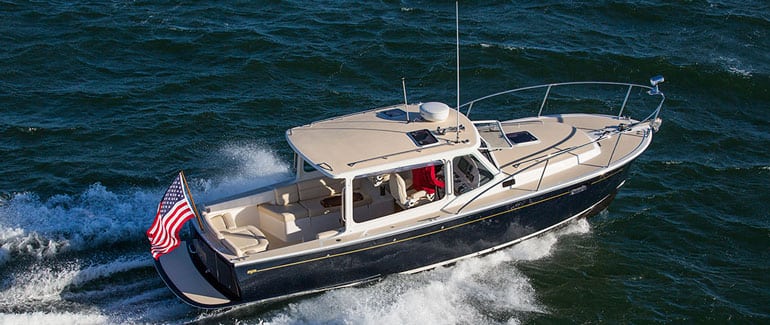
Mallows Bay to be a National Marine Sanctuary
Go for the grand on grand bahama.
Recommended
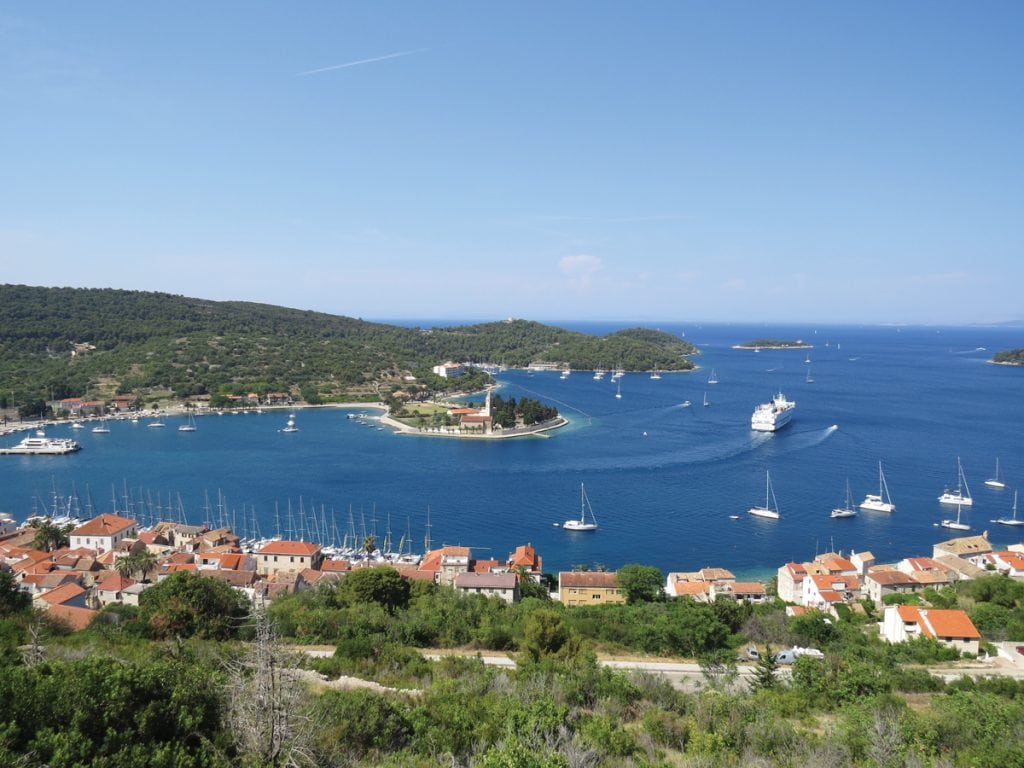
Cruising Croatia
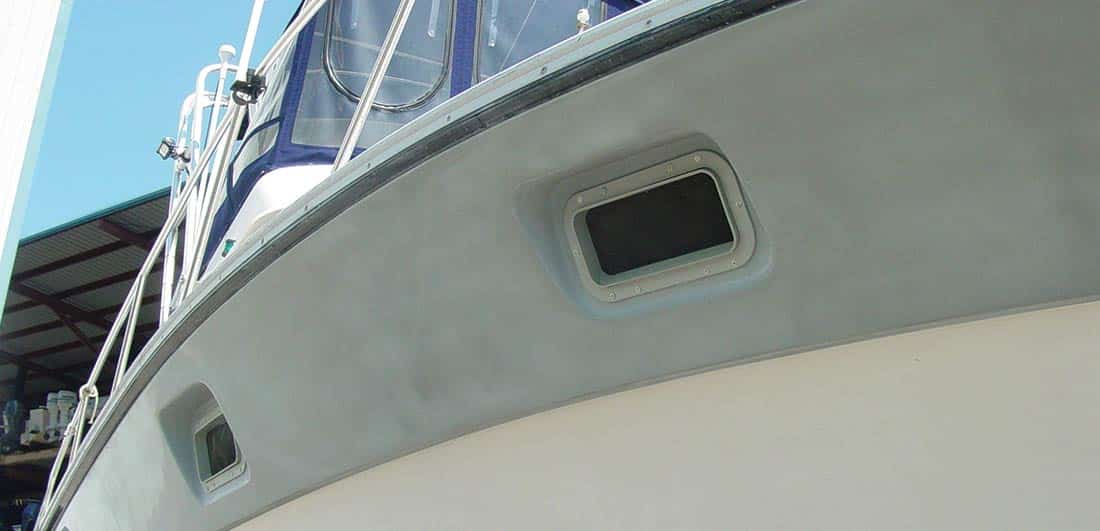
Ventilation Basics

Don't miss it

Marine Generator Maintenance: Helpful Tips You Need To Prevent Issues

Slow Down Ahead. How Much Will They Cut?

View From the Pilothouse – September 2024

Explore 4 of the Best US Boating Destinations: Michigan, Maine, and More!

End-of-Season Boat Maintenance: Winter Prep is Crucial to Ensure Peace of Mind

The Pursuit OS 405 Review: Reliable Comfort and Performance for Fishing and Cruising
- Terms Of Service
- Privacy Policy

1591 E. Atlantic Blvd, 2nd Floor Pompano Beach, FL 33060 Office: +1 (954) 522-5515 Fax: +1 (954) 522-2260 Contact us: [email protected]
© 2024 Southern Boating Media
- Bottom Painting & Prop Speed
- Fiberglass & Paint Work
- Running Gear & Valves
- Full-Service Team
- Monthly Maintenance Programs
- Dockside Service Team
- Full-Service Boatyard
- Management Services
- Accounting & Reporting
- Relevant Management Experience
- News and Media
Optimizing Efficiency, Economy, and Performance with Boat Fuel Tanks

In the realm of yachting, it is essential to understand how to manage your boat's fuel efficiently. Whether you're simply navigating calm waters for leisure or embarking on a grand journey, your vessel's performance depends on optimizing its fuel consumption effectively. This is where the significance of understanding boat fuel tanks and marine fuel can help to create a more enjoyable time out on the water.
Join Yacht Management South Florida as we dive into boat fuel efficiency, including exploring how you can increase efficiency, economy, and performance on your boating journeys.
Understanding the Basics of Boat Fuel Tanks & Marine Fuel At the heart of every vessel lies its fuel system. This system consists of a marine fuel tank, fuel lines, and other essential components designed to store and deliver the energy required for propulsion. The choice of a boat fuel tank and its overall capacity depends on the size of your yacht, and it will impact the range and endurance that your vessel can withstand.
A crucial aspect that must be considered is the type of fuel tank for a boat. Whether you have a vessel with a traditional rigid tank or one with a more flexible option, such as a boat fuel bladder, each has different advantages and limitations.
How Far Can a Yacht Travel on One Tank? A very common question is how far a yacht can travel on one gas tank. The answer truly depends on various factors, including the size of your yacht, its fuel tank capacity, cruising speed, and the conditions out at sea.
Below, we dive in for a closer look at each factor:
Vessel Size Large vessels typically have greater fuel tank capacities, allowing them to cover longer distances before refueling their tanks. Superyachts can carry thousands of gallons of fuel, enabling them to travel quickly across oceans. On the other hand, smaller boats and yachts have smaller fuel capacities, which may restrict their ranges.
Fuel Capacity The size of a yacht’s fuel tank will directly impact its range. Yachts with larger marine fuel tanks can travel farther distances on one tank of fuel than those with smaller tanks. The capacity of the fuel tank will vary between different types of vessels and even different manufacturers.
Cruising Speed The cruising speed at which a yacht runs plays a crucial role in its fuel efficiency and directly relates to its range. Operating a yacht at moderate speed within its optimal efficiency range will help to conserve fuel and extend the overall distance you can reach on one tank. A higher cruising speed will typically result in increased fuel consumption.
Sea Conditions The conditions of the ocean, including the wind, currents, and height of waves, can affect a yacht’s fuel efficiency. Navigating through a strong headwind or rough seas will require more engine propulsion and power, leading to higher fuel consumption and a reduced range. Calm sea conditions can enhance fuel efficiency and extend your yacht’s range.
How to Get Better Fuel Economy on a Boat Achieving better fuel economy can involve various factors, from efficient operation to proper maintenance and even innovative boating practices.
Here are some of the key strategies that will enhance fuel efficiency and maximize your vessel’s range:
Regular Maintenance One of the most effective ways to improve fuel economy is by regularly maintaining your boat’s engine and propulsion system. Schedule routine servicing of your vessel’s engine, which should include oil changes, filter replacements, and spark plug checks. Proper maintenance will ensure that your engine performs at its best, reducing fuel consumption. Yacht Management’s dockside care services will keep your vessel looking pristine and ensure that all aspects of your boat engine are running efficiently.
Reduce Drag & Resistance Minimizing any drag or resistance is a crucial aspect of improving fuel efficiency. Keep your hull clean and free of any marine growth, algae, or barnacles, which can increase the resistance while moving through water, known as drag, in addition to increasing fuel consumption.
To reduce resistance, we recommend trimming your boat’s engine accordingly to create efficient movement through the water. Trim tabs will help to adjust your boat’s attitude as it propels through the water and can help optimize fuel efficiency in various sea conditions. Yacht Management’s full-service team can aid in keeping your vessel’s hull free of growth.
Manage Weight Excess weight on board your vessel will increase fuel consumption. Removing unnecessary items and equipment will take the weight off your boat and improve fuel economy. Distribute the weight evenly throughout your vessel to maintain efficient balance and stability throughout your journey.
Plan Efficient Routes When planning a boating trip, consider the weather. Winds, currents, and tidal flows can directly impact fuel efficiency. Plan routes that will take advantage of favorable conditions, such as tailwinds or following currents, to reduce your fuel consumption. Avoid any unnecessary idling time to ensure that your engine is constantly running with a purpose.
By implementing these strategies, you can achieve better fuel economy on your boat and enjoy a cost-effective experience on your vessel. Small changes in your boating habits and maintenance routines can lead to significant savings, allowing you to maximize your time on the water.
Navigating Efficiency With Yacht Management South Florida In the realm of boating, one must achieve the balance between efficiency, economy, and performance with their vessel's engines. Investing in quality marine fuel tanks, adopting innovative fuel-efficient practices, and properly servicing your engines regularly will all help to optimize your boat's fuel consumption. Whether going on a leisurely cruise or an extended expedition, take the helm with Yacht Management South Florida to optimize your journey today.

For all inquiries, fill out the form below and a member of our team will respond as soon as possible

Top 10 Most Fuel Efficient Cruiser Boats | Buying Guide
Having the Most fuel efficient cruiser boat is both good for your savings account and safe for Mother Earth. By reading this buying guide, you will be able to know what are the Top 10 Most Fuel Efficient Cruiser Boats.
Also, you can know,
Introduction to the topic
Top 10 most fuel efficient cruiser boats, why are most fuel efficient cruiser boats getting popular.
- Watch Fast Powerboat fuel efficiency [Video]
Top 5 FAQ & Answers on most fuel efficient cruiser boats
Let’s start,

Fuel consumption is something that any motor yacht owner considers, whether it’s circumnavigating the world onboard your dream motor yacht or meandering down the Intracoastal to your favorite weekend waterfront watering spot.
Given the cost of gas and the numerous environmental challenges facing the planet, more and more boat buyers are looking for innovative boats that increase fuel efficiency and alternative propulsion systems. Owning one of these boats not only helps you minimize your carbon footprint and environmental effects, but it also helps you save money.
How Do Boats & Yachts Get Electricity When Sailing?
Let’s look at most fuel efficient cruiser boats
1. 2021 MJM Yachts 50z boat
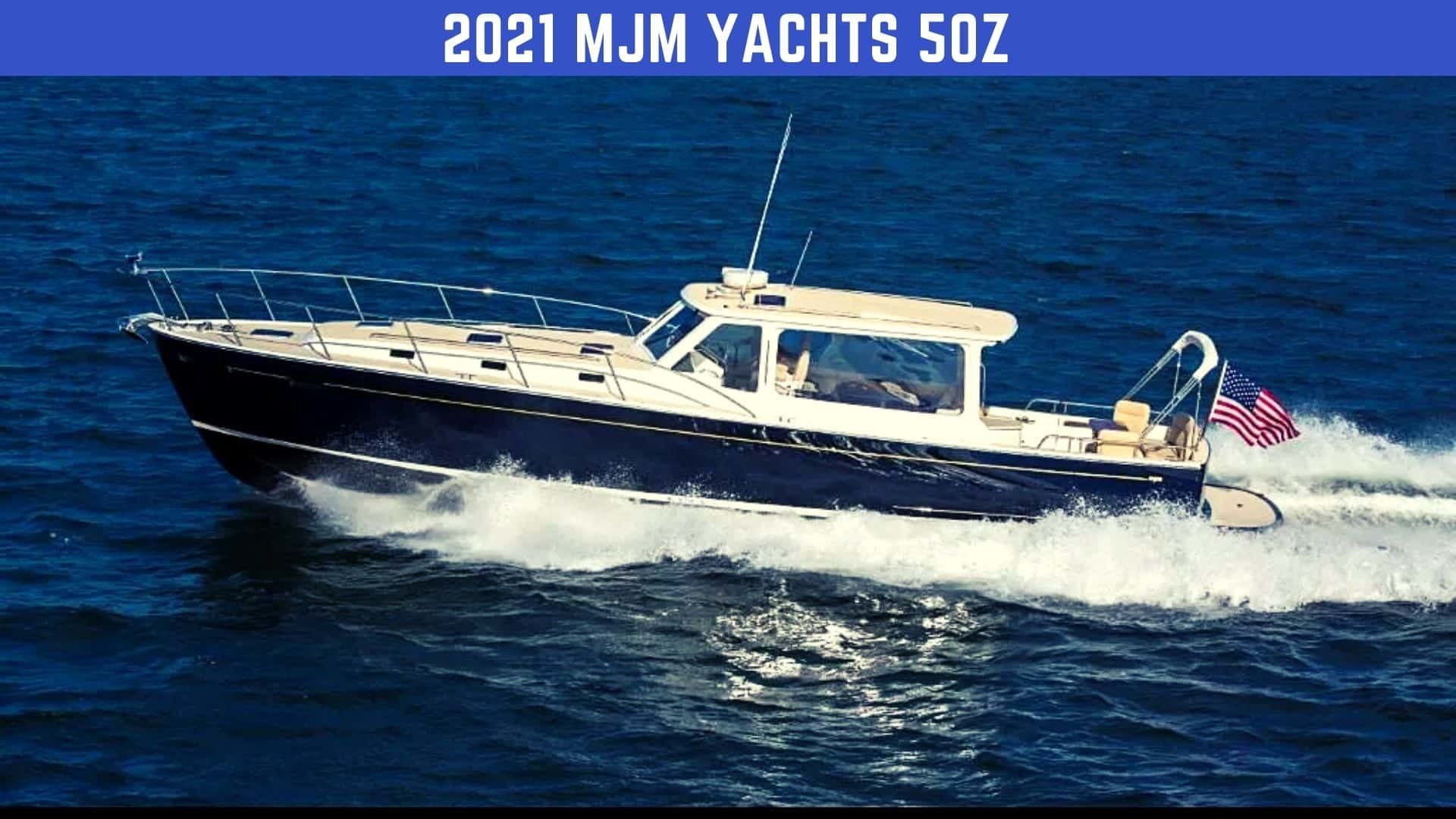
With advanced composite construction, an innovative design, and the latest stabilizing technology, the MJM 50z is an eco-smart game-changer. Its vertical Centre of gravity is very low due to its stronger, lighter epoxy construction. This leads to increased stability, ISO Category A seaworthiness, and an extremely comfortable ride.
The Sea keeper Gyrostabilizer with “no roll” was first provided as standard equipment on the MJM 50z. Adding comfort and living space: The flush-deck design, equipped with floating door sideboard doors, removes the various access problems facing other yachts.
You want to be able to look at your boat with pride and know that you are the proud owner of a work of art. A boat that gets compliments as soon as it reaches the harbor, rather than one that is “here now, gone tomorrow.” Doug Zurn was chosen as the designer because of this. He produced the Shelter Island 38 for singer Billy Joel because he has the best eye in the business. A U.S. design patent protects the MJM signature look. Other significant advantages of the 50z’s slim profile include Lower bridge clearance, improved seaworthiness, quicker hose-down after use, less windage, and easier overland trucking.
Specifications
| Length Overall | 55 ft |
| Beam | 15 ft |
| Maximum Speed | 40 kn |
| Dry Weight | 32850 lb |
| Length of Deck | 50 ft |
| Water Capacity | 150 gallon |
| Dead Rise | 18.6 degree |
| Minimum Draft | 3 ft |
| Maximum Draft | 3.83 ft |
| Fuel Capacity | 534 gallon |
| Seating Capacity | 30 |
| Number of Heads | 2 |
| Hull Material | Composite |
| Hull Design | Deep Vee |
US$1,890,000
2. 2009 MJM Yachts 29z Express
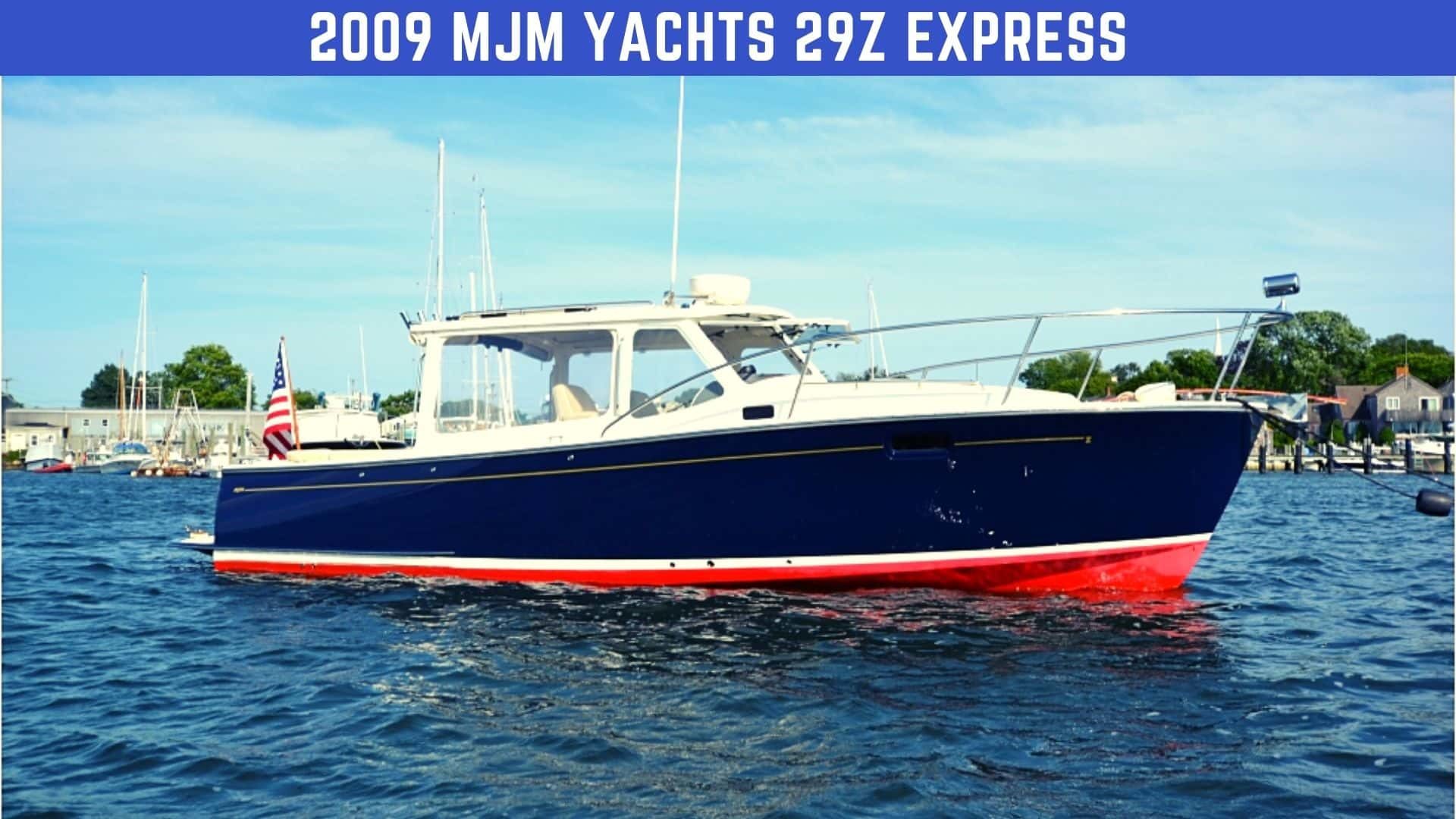
Do you want comfortable, most fuel efficient cruiser boats? Why would you want to buy another boat? This graceful Doug Zurn style is perfect for a couple looking to downsize from a larger power or sail yacht. The 29z has a welcoming layout but is light and narrow enough to dock without assistance.
The vacuum bagged, oven-cured Kevlar/epoxy is the key to the breakthrough. This cutting-edge construction method is unique among powerboats, resulting in improved performance and fuel efficiency. This 29z has been well maintained and has just a few hours.
The 29z is the world’s only 29-footer able to offer such a fuel-efficient, dry, and comfortable ride. This is due to the vacuum-bagged and oven post-cured high-tech epoxy wet pre-preg Kevlar / E glass / Core cell composite laminate. The construction is ISOCE, Labelled as a Category B Offshore Power Yacht. Also, there is no wood on the deck to maintain.
It’s an incredible design achievement to have six feet of headroom in a 29-footer and still have a beautiful boat. When compared to other 29-footers… or even a 38-foot luxury runabout, people wonder at the living space below, the broad head, and the galley.
| Length of Deck | 29 ft – 8.84 meter |
| Dry Weight | 7600 lbs |
| Model | D4 |
| Engine(s) | 1 |
| Engine Type | Inboard |
| Drive Type | Stern Drive |
| Fuel Type | Diesel |
| Horsepower | 260 (Individual), 260 (combined) |
| Fuel Tank | 125 gallons – 1 tank(s) |
| Beam | 10 ft. 2 in to 3.1 meter |
3. Greenline Hybrid Yachts
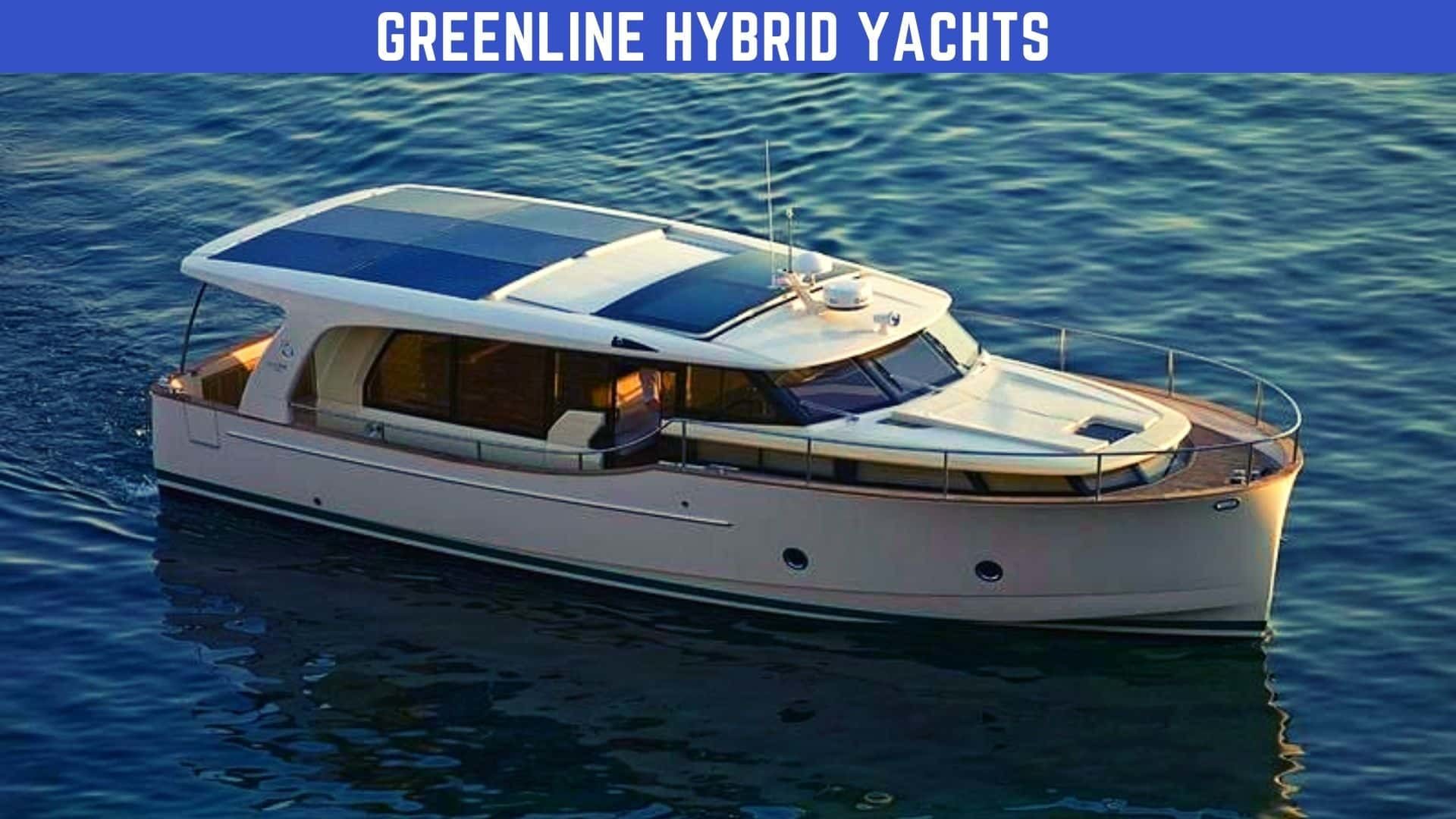
For years, Greenline has been a pioneer in the field of hybrid diesel-electric and solar-powered yachts. Greenline’s hybrid-drive systems integrate conventional and revolutionary technology, making them an ecological landmark for yacht builders.
Both Greenline Hybrid yachts have a reliable and cost-effective diesel-electric and solar-powered drive system that is fully emission-free in electric mode. The revolutionary yacht builder has helped set new standards for sustainability and responsibility while preserving luxury and style.
The revolutionary yacht builder has managed to set new standards for sustainability and accountability – while retaining comfort and style. The Greenline Hybrid yacht line currently includes eight versions, including the trendy NEO sports boat, the family cabin cruising 33, 39, and 40, as well as the 45 Fly, 48 Fly, 48 Coupe, and 65 O.C. Many of these versions have the best fuel economy in the industry.
| Length overall | 33′ |
| Beam overall | 11’5″ |
| Draft loaded | 2’7″ |
| Air draft | 8’4″ |
| Displacement empty | 4.800 kg |
| Cabins | 2 + 3 (+2) |
| Diesel tank | 132 gal |
| Water tank | 79 gal |
| Black water tank | 16 gal |
| Diesel max range @ 7kts | 700 Nm |
$255,000.00
4. Hinckley Dasher 2.0

Hinckley’s Dasher 2.0 was designed from the ground up to be fully electric. This boat, like SILENT-YACHTS, does not require the use of fossil fuels to get from point A to point B. The Whisper Drive propulsion system on the Dasher offers quiet propulsion and zero emissions. It is powered by dual BMW i3 lithium-ion batteries, designed for compact size and superior shock resistance.
With a carbon-epoxy composite hull and complete carbon stringers, the Dasher is the lightest Hinckley Yacht ever made. This latest 2019 model has timeless styling, comfortable seating, and a longer range than the initial Dasher.
| Length | 8.53m (27’12”) |
| Beam | 2.44m (8’0″) |
| Draught | 0.3m (0’12”) |
| Weight Dry | 3250 |
| Maximum Speed | 23.0 kn |
| Cruise Speed | 7.0 kn |
| Engine Location | Inboard |
| Electric | No |
| Custom | No |
| Builder | Hinckley Yacht Services |
5. 2009 MJM Yachts 34z
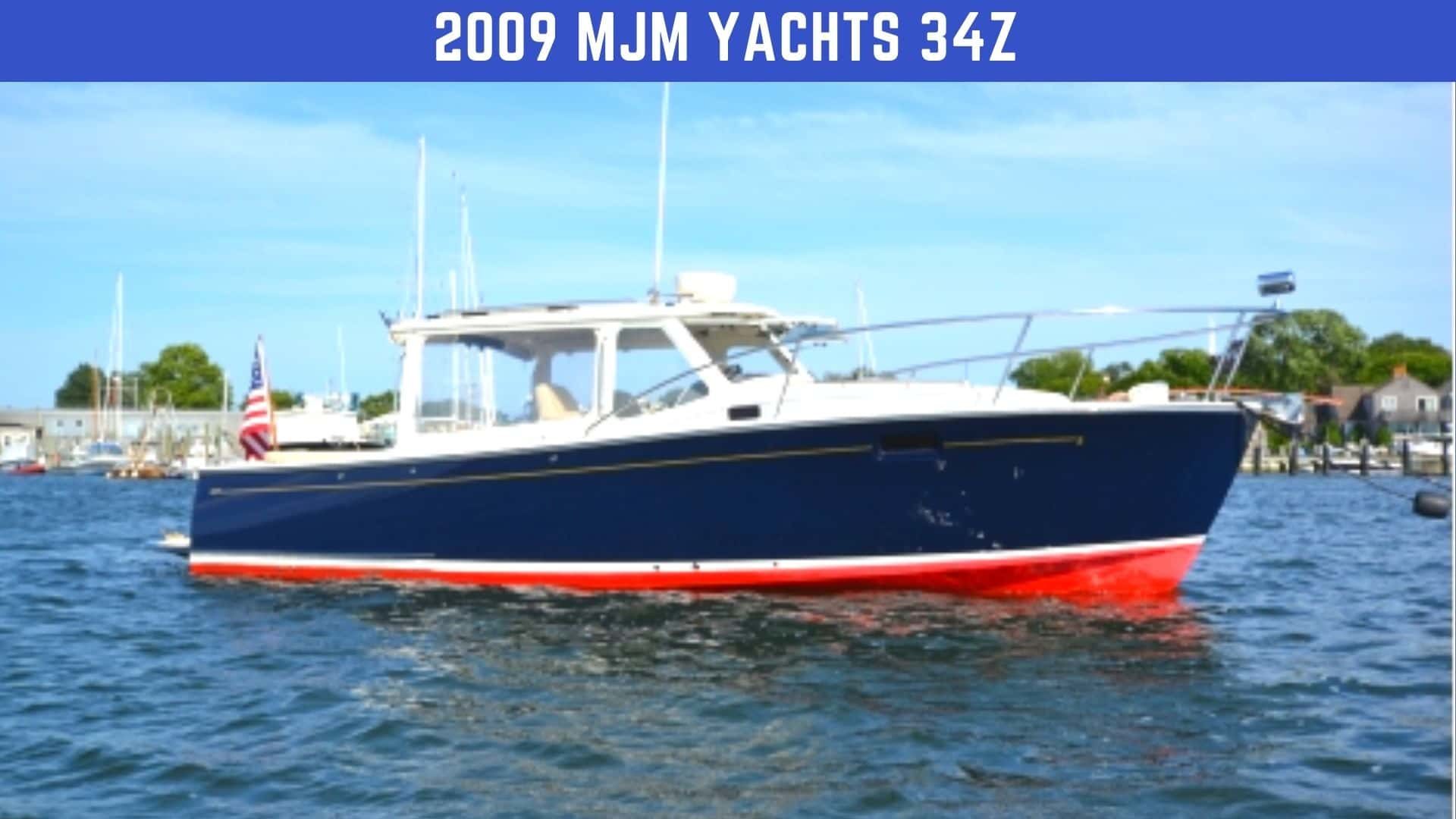
ZINGARA is most possibly the best MJM 34Z ever listed for sale. She is Hull #63, and she was nearly the last model constructed before the 36Z was introduced. The original owners, who are heading up to a larger retirement yacht, have gently used and enjoyed this boat.
ZINGARA is in excellent condition, has always been garaged, and comes fitted with all of the required features. 350 hours on the Yanmar 440 and 46 hours on the Northern Lights Genset are among the highlights. Upgraded inverter 2013, fresh Textilene covers 2014, and lovely teak decks on the pilothouse and aft deck.
“For good fuel economy, the hull is strong but lightweight. The [28-inch] draft is suitable for cruising in shallow water, and the single diesel engine helps the builder to place the engine where it belongs for effective following-sea tracking. The 34z also handles well, which is critical when a cruising couple deals with various sea conditions. “Except for very bad conditions, the pronounced bow flare offers a dry ride,” Gentry says.
| LOA | 37 ft 5 into 11.41 meter |
| Beam | 11 ft – 3.35 meter |
| Model | Yanmar |
| Engine(s) | 1 |
| Hours | 350 |
| Cruise Speed | 25 MPH |
| Engine Type | Inboard |
| Fuel Type | Diesel |
| Horsepower | 440 (Individual), 440 (combined) |
| Max Speed | 30 MPH |
| Fuel Tank | 72 gallons – 2 tank(s) |
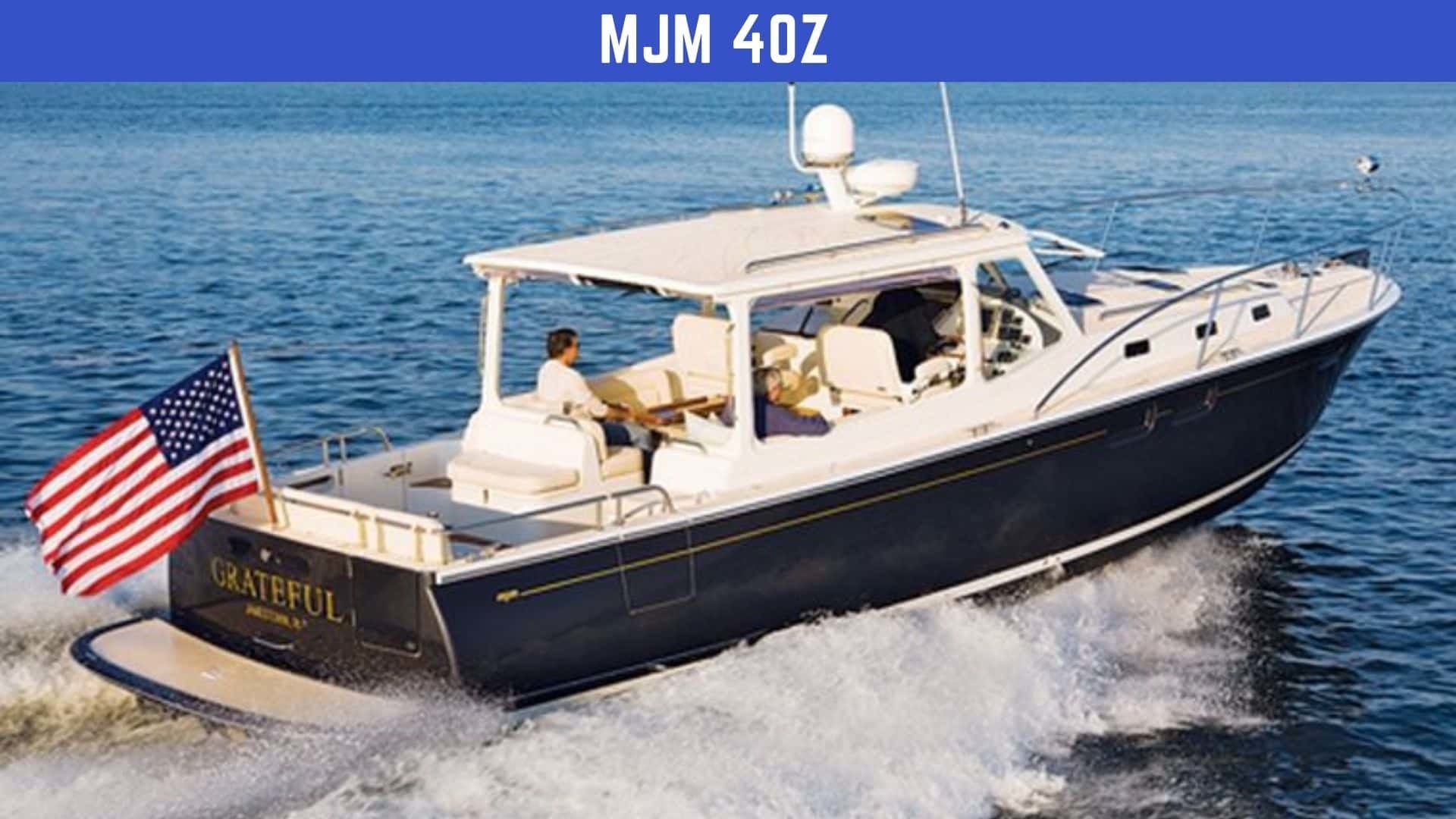
Zurn Yacht Design has been demanded to build a 40-foot ISO Certified Category A Ocean Yacht that will deliver a maximum rating of navigability and protection while retaining the performance and fuel efficiency of the MJM brand.
Only one other boat of this size, a heavy trawler, had been given this designation, so the challenge at hand demanded meticulous work in every aspect of the design to achieve strength while remaining light. The design brief was fulfilled, and the 40z is an exceptional powerboat.
Her twin Volvo IPS 500 engines drive her to a top speed of about 40 knots, with a cruise speed of 33 knots. These same drives allow her to dock with joystick control and station-keeping abilities. The optional Seakeeper gyrostabilizer can improve relaxation and minimize exhaustion at rest and while underway for those who don’t want to roll. MJM’s Bob Johnston states, “the 40z offers value, quality, operating ease, and peace of mind that are simply not available in other luxury yachts her size.” “She has everything you need for a weekend cruise or a Bahamian adventure.”
| LOA | 44′ 0″ |
| Beam | 12′ 0″ |
| Draft (Total) | 3′ 4″ (IPS) |
| Displacement (50%) | 18,910 lb |
| Standard Power | (2) Volvo IPS 500 hp |
| Speed (Cruise) | 32.5 kt |
| Speed (Max) | 38 kt |
| Range (Cruise) | 342 nm |
| Fuel | 350 gal |
| Water | 100 gal |
| Builder | Boston Boat Works |
$1,050,000.
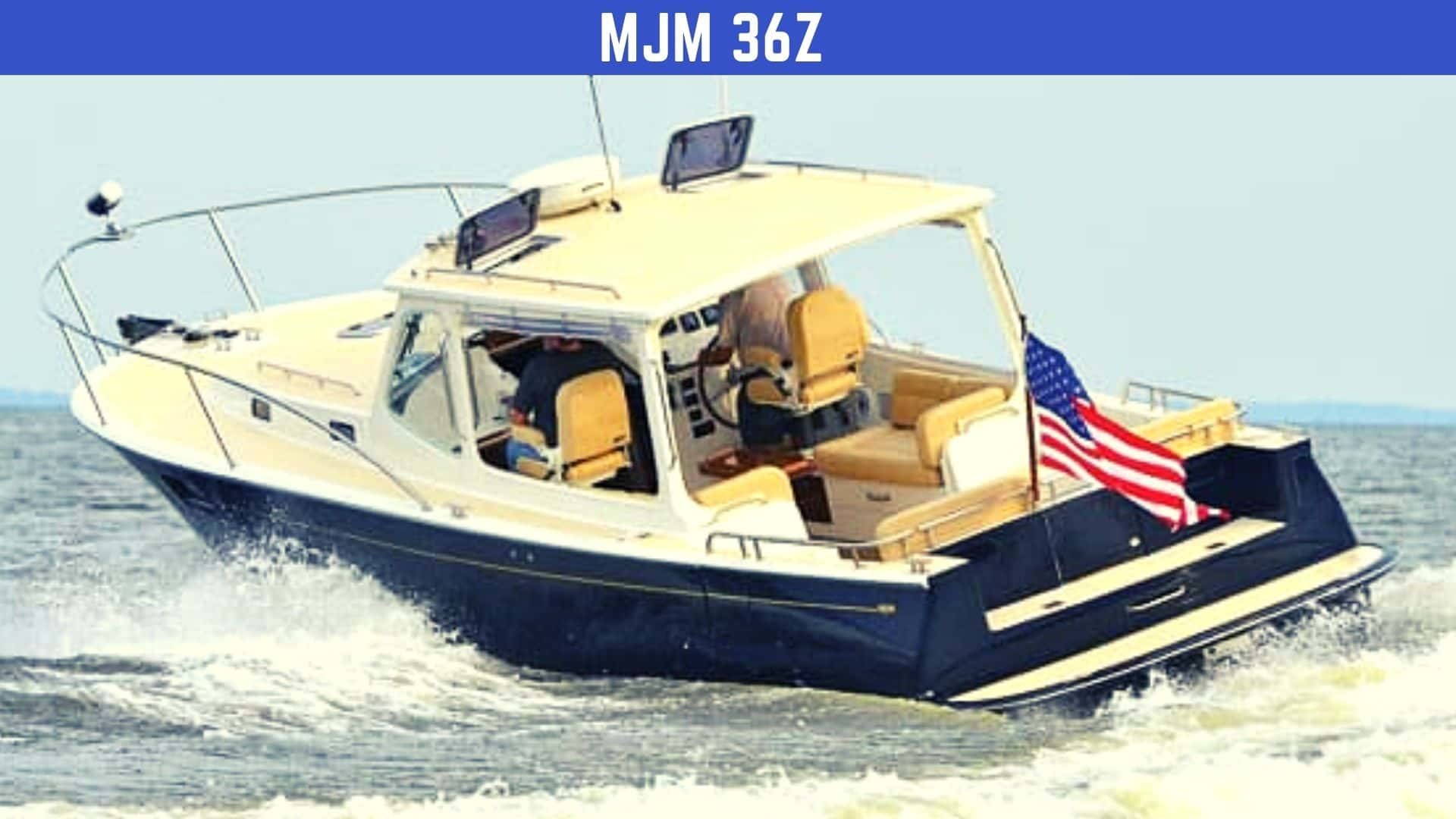
MJM increases the length of its famous 34z by two feet, resulting in a faster and more fuel-efficient boat. The 36z Express model provides a styling alternative for those who might prefer it for the looks, for activity in rougher waters to provide ventilation without having to hold the Strata Glass side opening curtains down, or for a bit more protection for small kids climbing up on pilothouse settees. The Down East and Express models are almost identical except for the layout of the pilothouse side windows.
The 36z is probably among MJM’s most quiet running boats. That is because, thanks to the extra Sundown insulation and the strength of their electronic structure, all of them have low noise levels. The new generation of Volvo-Penta turbocharger 4-stroke diesel, with a cleaner, low-emission running Power installed in the stern, makes the 36z different. The marinized models in their luxury wagon XC-70 in Europe of the diesel engines have just been launched on the U.S. market.
| LOA | 39’3″ |
| Beam | 11’0″ |
| Draft | 2’6″ (props down) |
| Fuel Capacity | (In Gallons) 200 |
| Water Capacity | (In Gallons) 100 |
| Standard Power | 2/170-mhp Volvo Penta D3 diesel matched to Ocean X stern drives. |
| Optional Power | 2/300-mhp Volvo Penta D4 diesel with Ocean X stern drives |
| Displacement | 13,100 lb. |
| Hull Material | Fiberglass |
| Hull Type | Modified Vee |
| Horsepower | 220 |
8. SILVERFIN
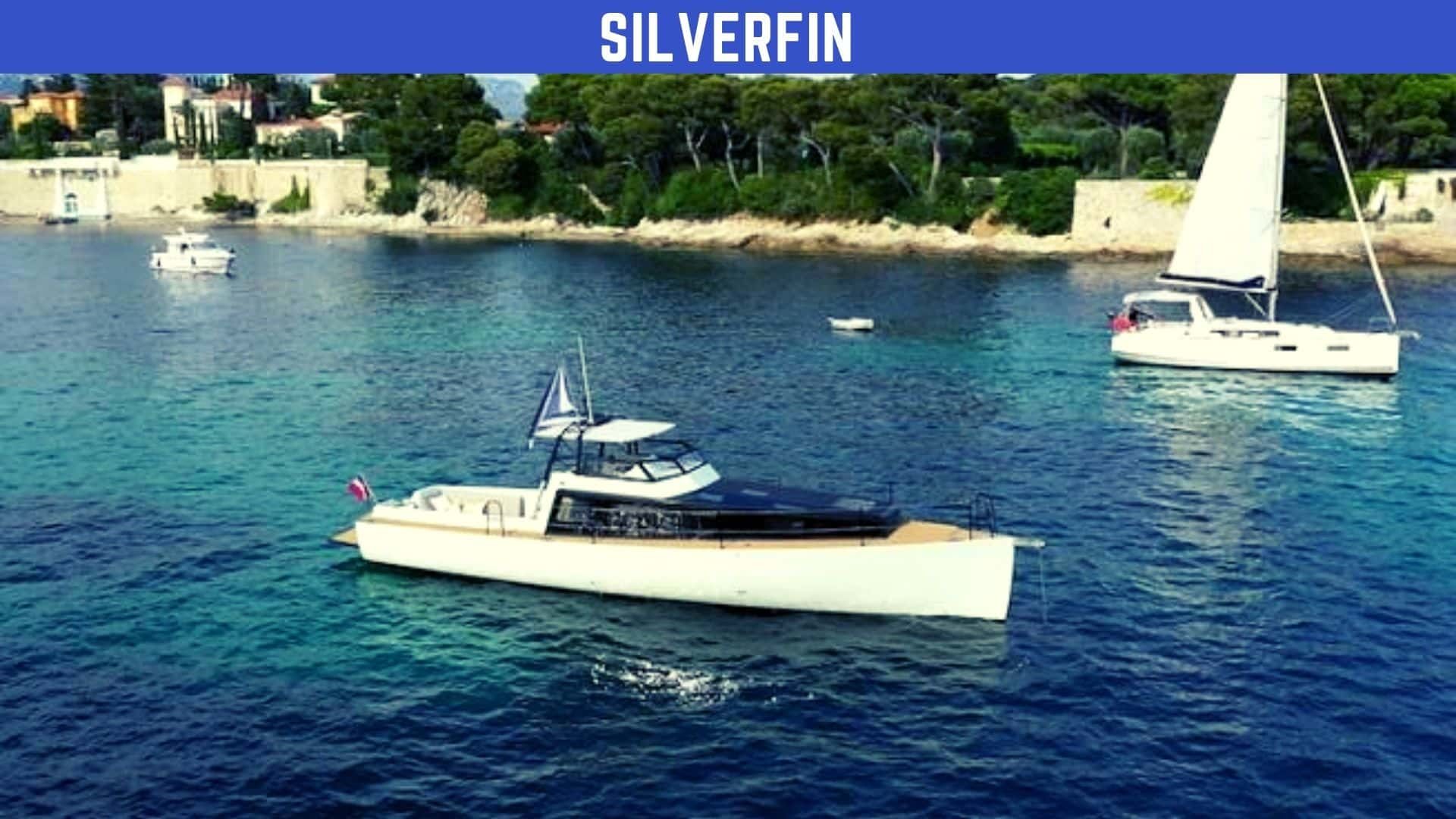
Silverfin is among the most fuel-efficient motorboat trawlers in the world. SILVERFIN is a 12-meter motor yacht multifunctional design. The style is reminiscent of classic commuter yachts but with a contemporary look – Fabrice Clapot’s outstanding retro classical design with the latest naval architecture.
Clients can choose from various layouts and designs to meet their budgets: A cruise with cabin, cookery, bathroom, and lounge dining can be ordered. The limo version is available as a chase boat, superyacht tender, or hotel shuttle, with views of the sofas, a head boat, and bar. There is much natural light in the interior on a wide glass surface.
The SILVERFIN’s top speed is 20 knots. It has an area of 400 nautical miles with a cruising speed of about 12 – 15 knots. A lounge area is on the wide-open cockpit. It turns a retractable table into a dining room but could also be a sunbed area. An awning system can provide shade.
| Length overall (without platform) | 12.00 m |
| Beam | 3.30 m |
| Draft | 0.90 m |
| Height | 4.20 m |
| Displacement (light) | 4.500 kg |
| Displacement (fully loaded) | 6.000 kg |
| Engine | Volvo Penta D3-220 (162 KW) or Volvo Penta D4-230 |
| Fuel | 500 l |
It starts at 400.000 €.
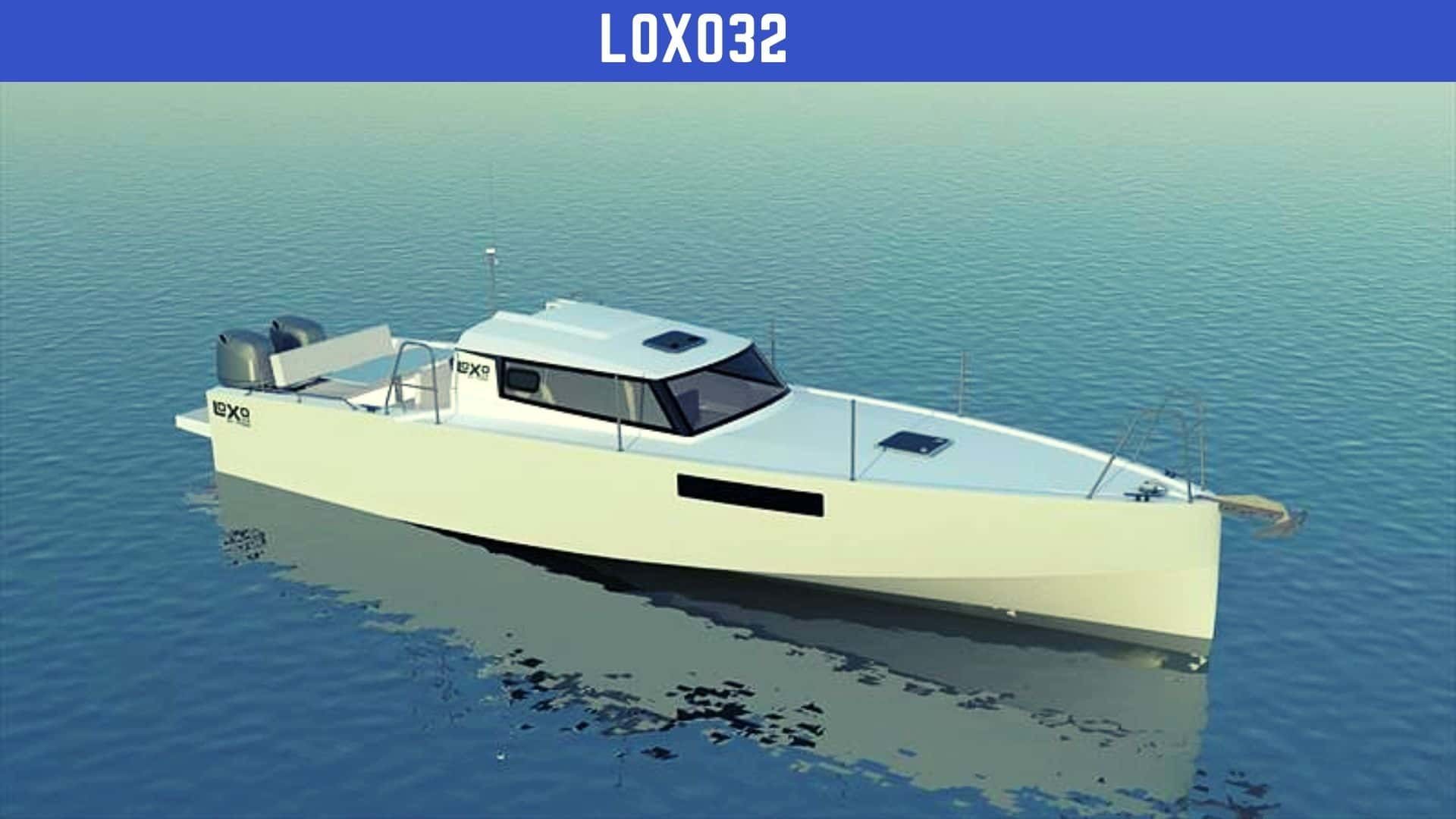
The Loxo32 is a cruising boat that is highly fuel-efficient. The Loxo 32 is a brand-new cruising motorboat. Built with cutting-edge construction technology. Her displacement is extremely light, allowing for a hybrid hull design with extremely early planning and low propulsion power requirements. She is designed for cruising speeds of 10 to 15 knots and will allow you to cruise with amazing efficiency: around 0.5 liter per nautical mile, a world record.
Her contemporary architecture, combined with the brightness of the interior, creates a welcoming and relaxing atmosphere. The large sunbath and small folding tailgate will ensure you enjoy all the ideal mooring moments.
The Loxo 32’s construction has been carefully designed to meet the performance goals. The Loxo 32’s construction has been meticulously optimized to meet its performance goals. Glass fiber/foam sandwiched with polyester or vinyl ester resin makes up the hull, deck, and all structural parts. Infusion is used for all of the parts. This vacuum process enables us to produce high-quality composite parts while reducing weight.
| Length overall | 9.5 m |
| Max beam | 2.55 m |
| Draft | 0.70 m |
| Berths | 4 |
| Fuel capacity | 150L |
| Water capacity | 150L |
| Cruising speed | 10-12 Knots |
| Maximum speed | 16-20 Knots |
| Autonomy | 300 nautical miles |
10. Viking Yachts 42 Convertible – Most Fuel Efficient Cruiser Boats
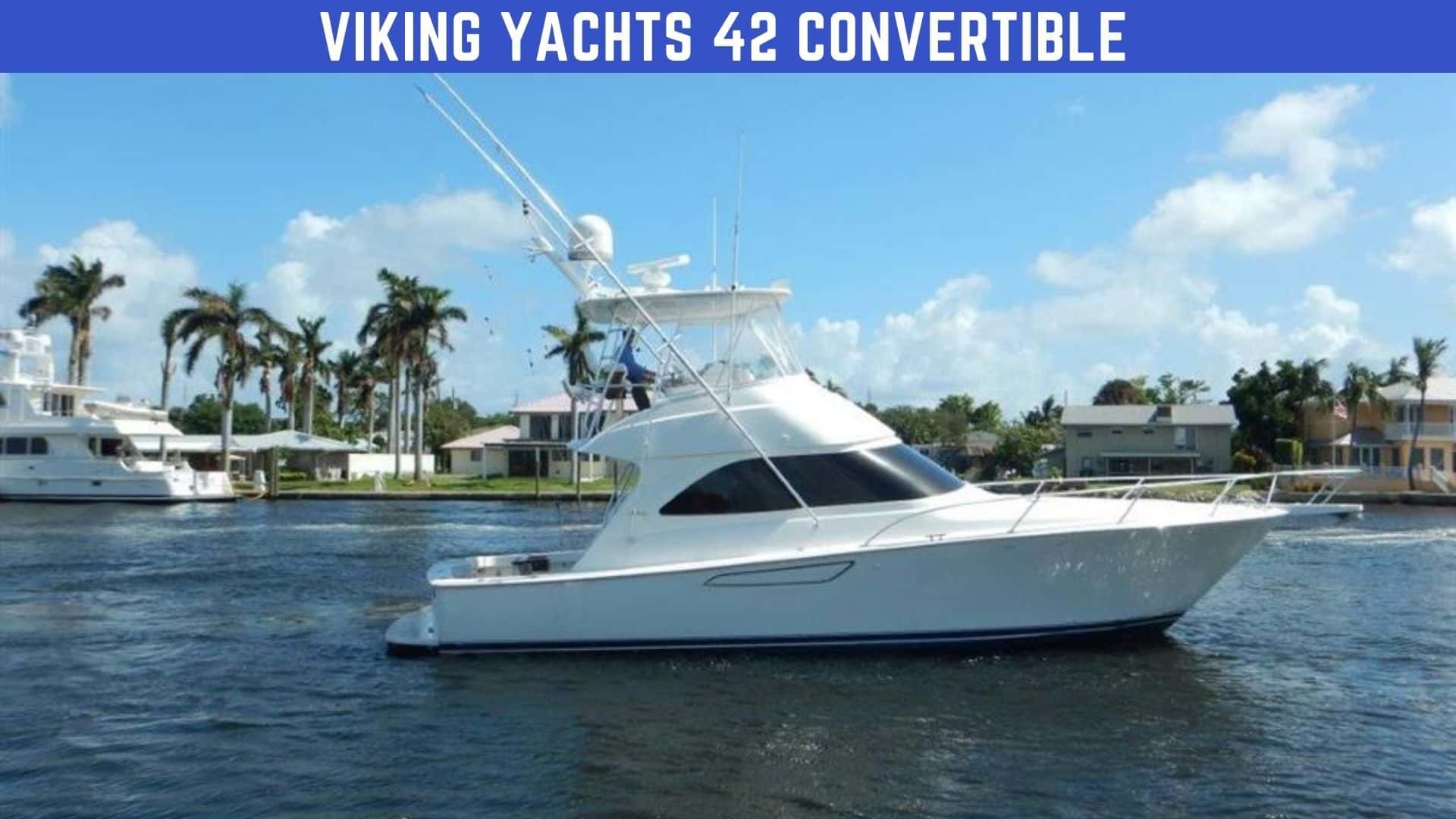
This fuel-efficient express cruiser yacht is spacious and relaxing for family days on the water and serves as a great fishing boat. With this beautiful boat, you really can have it all. This express cruiser yacht will accommodate the whole family.
It has 3 cabins on board, not 1, not 2, but 3. This also makes it a great choice for overnight fishing trips with the guys. Or, for a day in the sun, take a romantic cruise on the water with just the 2 of you or your closest friends. The boat’s fuel efficiency does not detract from its performance. Two 440 HO Cummins MerCruiser diesel engines have a cruise speed of 28 knots and a top speed of 30 knots.
This one-of-a-special boat is ready to go on those long family holidays, even in saltwater. The 122-square-foot cockpit offers enough space for comfort and relaxation. An L-shaped lounge and cocktail table, as well as a flat-screen television and Bose stereo system, provide additional enjoyment in the salon.
You’ll be boating high-class when you take this boat out on the lake. For those long boating tours on the lake, the spacious master stateroom features another flat-screen T.V., a queen-size berth, and plenty of storage. This boat is built for family entertainment and fishing.
| Length | 42′ |
| Length Overall | 42′ 7 |
| Beam | 15′ 10 |
| Max Draft | 3′ 7 |
| Displacement | 35,999 Lbs. |
| Fuel | Diesel |
| Engine Power | 600 HP |
| Engine Power | 600 HP |
| Total Engine Power | 1,200HP |
US$649,000.00
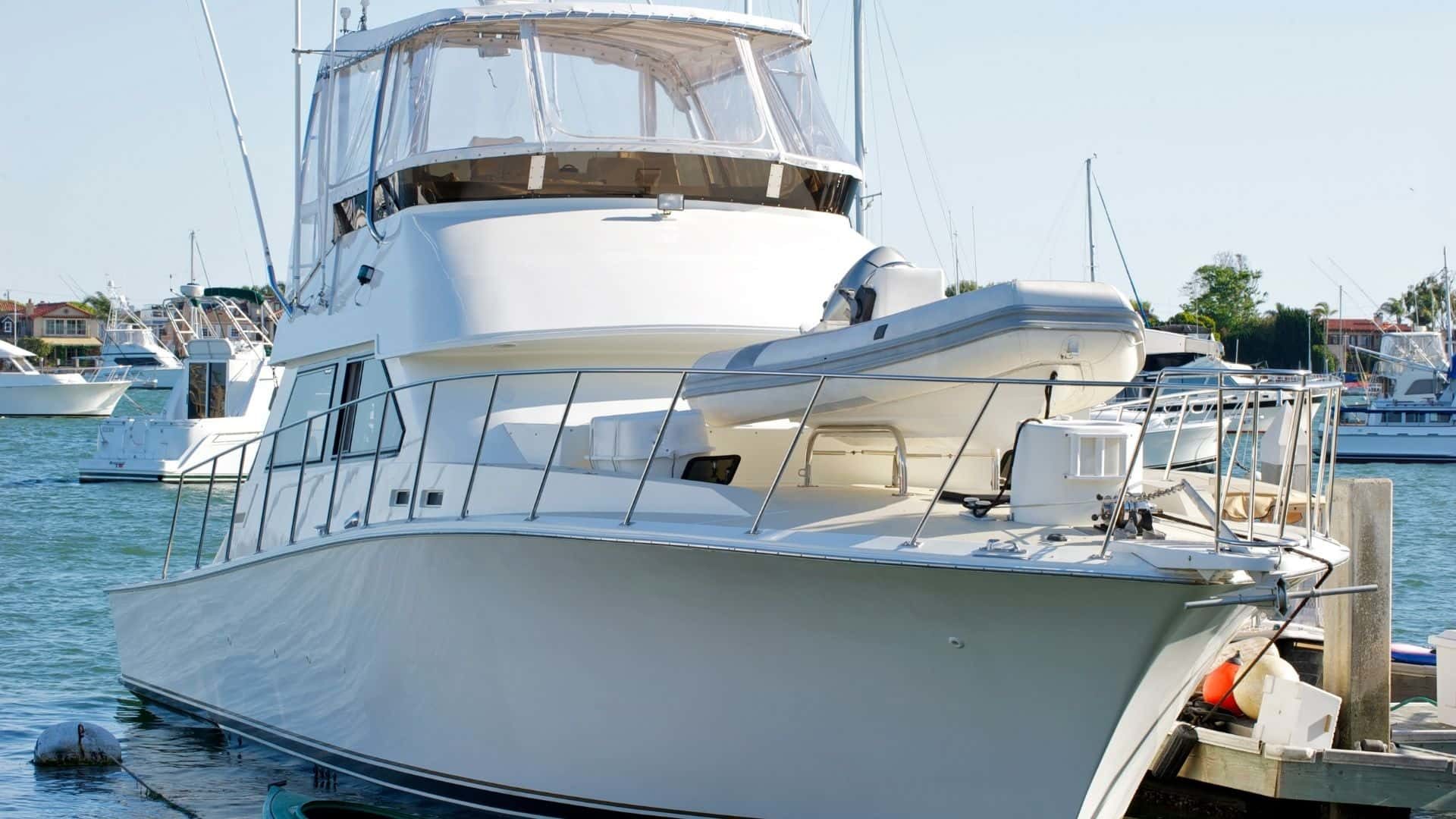
The most fuel efficient cruiser boats are becoming increasingly popular because
1. Eco-friendly
Fuel efficiency is vital if you want to reduce the environmental impact of your trips. Owners of fuel-efficient boats are helping to make the world greener by reducing their carbon footprint. Hydrocarbons, particulates, nitrogen oxides, and various other pollutants are minimized in the environment.
A fuel-efficient performer leads to a more comfortable, environmentally friendly life on the water… not to mention less time and money spent at the fuel dock. And, as with a good stock, it’s not so much about the initial investment as it is about the continuing running costs and how well it retains its value over time.
2. Cost-effective
Increasing fuel efficiency saves you time by reducing the number of trips to the fuel dock and the cost of using less fuel.
3. Boats that save fuel help us become more energy-sustainable
Although new technology is being developed, using more fuel-efficient boats today allows the United States to buy time before more renewable fuels and alternative technologies become available.
4. Cheaper maintenance
In addition to being more fuel effective, most of the better fuel-efficient boats need less maintenance than a regular boat. Since they are less complex and have standardized components, these boats are usually less expensive to maintain. As a result, any required maintenance is both inexpensive and easy.
Watch Fast Powerboat Most Fuel Efficient Cruiser Boats [Video]
Conclusion – Most Fuel Efficient Cruiser Boats
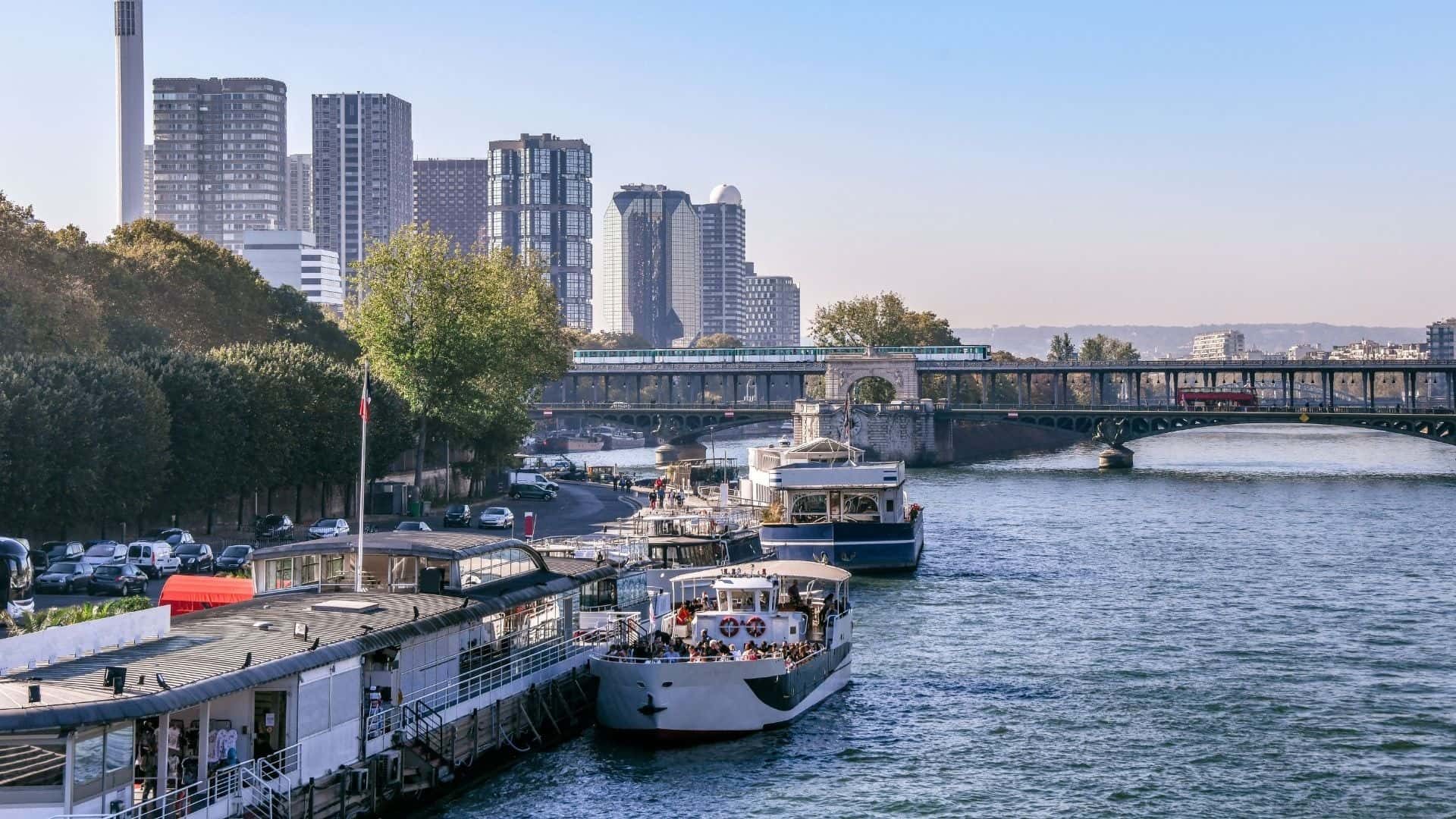
We must consider purchasing fuel-efficient boats in today’s world, where there is a lack of fossil fuels, increased emissions, and global warming. We will help to mitigate the harm that is being done to our environment by doing so. When you purchase a boat that is known for being fuel-efficient, you know you are helping the environment as well as yourself.
We are protecting our future by conserving our environment. Efficiency has been increasing throughout many boats due to increasingly strict fuel economy standards and higher customer demands, making it easier than ever to find a fuel-efficient model that fits your budget and needs.
Bottom Up – Most Fuel Efficient Cruiser Boats
So, I hope you got the full idea of the Top 10 Most Fuel Efficient Cruiser Boats | Buying Guide.
Please comment below about your ideas and share this “ Top 10 Most Fuel Efficient Cruiser Boats | Buying Guide ” article with your friends.
Stay tuned to our website to find out more exciting stuff. Don’t forget to check out our previous articles too.
Until then, Read about, the Top 10 Most Common Problems with Boats [Guide to Fix]
Have a good day!
Related Posts

How to Sell My Yacht Fast & Easily for Higher Price?
Top 10 most luxurious yachts in the world | guide, what to know before buying a yacht to live on | guide.

How Fast Are Speed Boats?
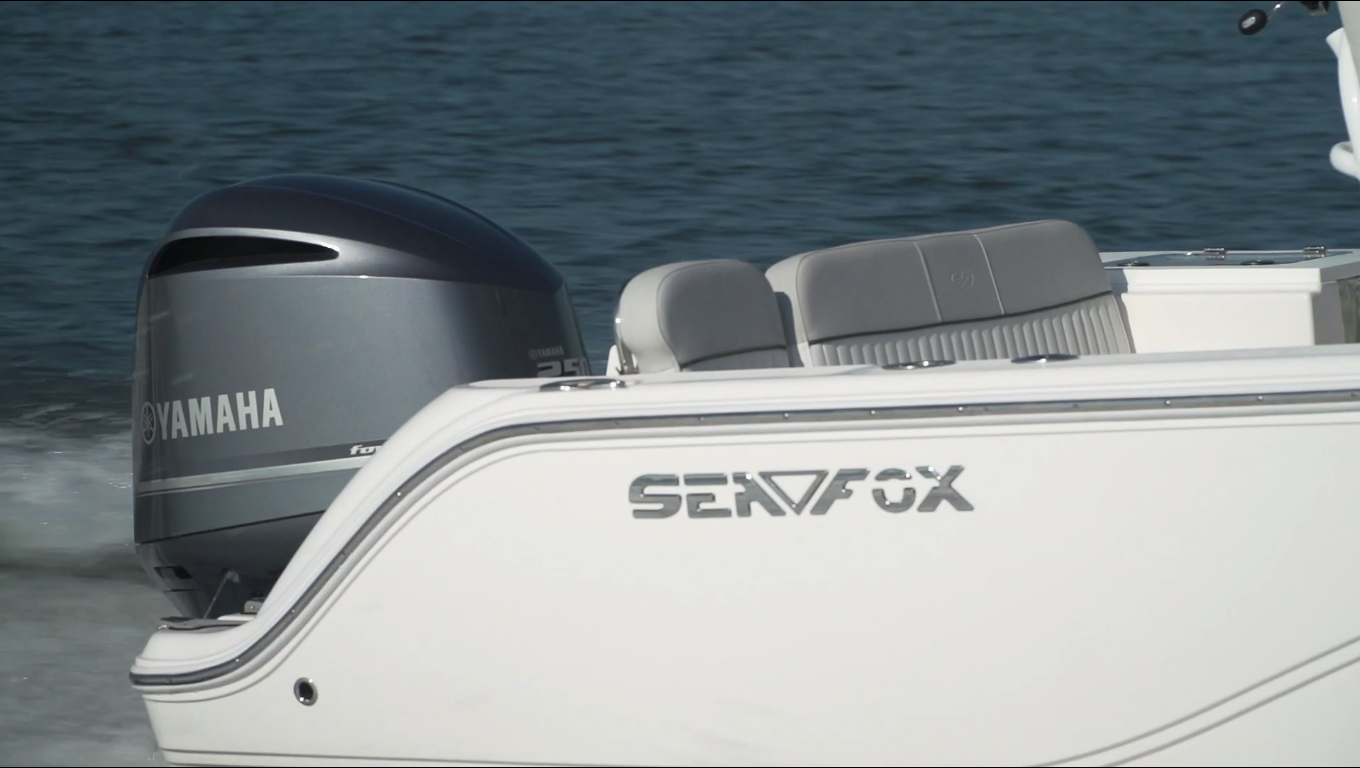
Sea Fox Boats Review – Special Features Of Sea Fox Boats?
10 best boat insurance companies for your boat | guide.
|
|
| | ||
|
|
|
|
|
|
| |
|
|
| |
|
|
| |
|
|
| |
| | ||
Boat Fuel Economy - Sea Ray Fuel Consumption / MPG calculator, GPH | Boat Models:
Sundancer 230 - 240 - 250 - 255 - 260 - 265 - 270 - 280 - 300 - 305
Sport 190 - 205 - SLX 210 - 230 - 250 - 270 - 300 - Sundeck 220 - 240 - 260 - 280
Bow Rider 160 - 175 - 176 - 182 - 185 - Weekender / Sun Sport - Pachanga 22 - 27 - 32
- Work & Careers
- Life & Arts
Russian oligarch Andrey Melnichenko berths superyacht in UAE
Keep abreast of significant corporate, financial and political developments around the world. Stay informed and spot emerging risks and opportunities with independent global reporting, expert commentary and analysis you can trust.
Try unlimited access Only $1 for 4 weeks
- Then $75 per month
- New customers only
- Cancel anytime during your trial
Keep reading for $1
Explore our subscriptions
Find the plan that suits you best.
Professional
Premium access for businesses and educational institutions.
- Get Started
Check if your university or organisation offers FT membership to read for free.

U.S Navy Commissions USS New Jersey, First Ever Submarine For A Mixed Gender Crew

World’s Largest Hotel-Branded Superyacht Sets Sail For Maiden Voyage

India Establishes Its First Maritime Arbitration Center

Yanmar Unveils Its First Electric Propulsion Product For Emission-Free Sailing

7 Major Ports in Russia
As the largest of all the landmasses in the entire world, Russia has an extensive coastline. It features on the periphery of the Arctic Ocean surrounding its entire North for trading prospects. The Barents Sea, with the South-Eastern side touching the Sea of Japan encompasses the major ports in Russia.
60% of the total cargo movement on the international scale for Russia takes place through the sea. This includes almost 722 million MT (2016) cargo movement through international vessel calls.
A staggering 67 thousand plus ship calls come through this busy network every year. However, the modern handling facilities ensure that the median handling time for these ships remains 1.45 days. This means the port facilities under the Russian Government’s reach are the best in the business!
As a shipping nation, the Russian seafarers are plenty in number across the globe. The country’s shipping strength boasts over 2820 vessel registrations and 98,000 seafarers under them.
Major Ports Of Russia
In this article, we review the major ports in Russia of inland and international importance. We highlight their share in building the 571 496 million current US$ shipping market in the country. The details also contain their accurate location, identity code, and other geographical information.
1. Port of Novorossiysk (Krasnodar Krai, Russia)
UN/Locode: RUNVS Latitude: 44.720065° Longitude: 37.81373°
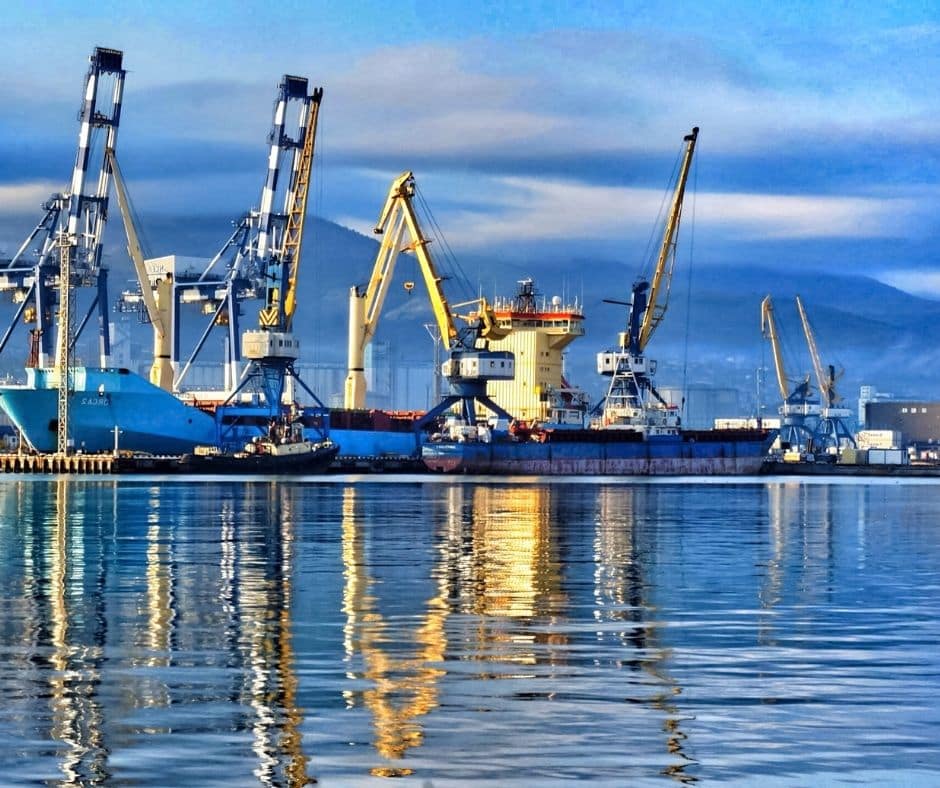
The port of Novorossiysk has a 3.4 sq. km harbour area with a land area worth 2.7 sq. km. This includes a total of 89 functioning berths for vessels of all sizes. It features as the biggest seagoing port for Russia for over decades with almost 50% higher turnover.
The establishment of the port of Novorossiysk dates back to 1829, with major exchanges since 1846. The port’s range of services recorded 143 million MT of cargo handling for 2020. It includes one of the first Timber wood handling facilities to feature across the Black Sea ports.
Cargo Handling
A total of 11 berths are important in handling timber and other bulk cargo. 4 separate berths over a quay length of 570 meters handle the container operations. The sheer size of the facility allows maximum handling limits of 208 million MT every year.
Network and Layout
The timber operations across the 4 berths (31, 32, 31/A, 31/5) are the most advanced facility across Europe. Their throughput every year crosses figures between 400 thousand to 600 thousand.
This connects with direct railway and loading facilities, reaching out to 70% of timber industries. Meanwhile, 180 thousand and more TEU capacity of container handling adds to the port’s large-scale profits.
2. Port of Saint Petersburg (St. Petersburg, Russia)
UN/Locode: RULED Latitude: 59.91933° Longitude: 30.327035°
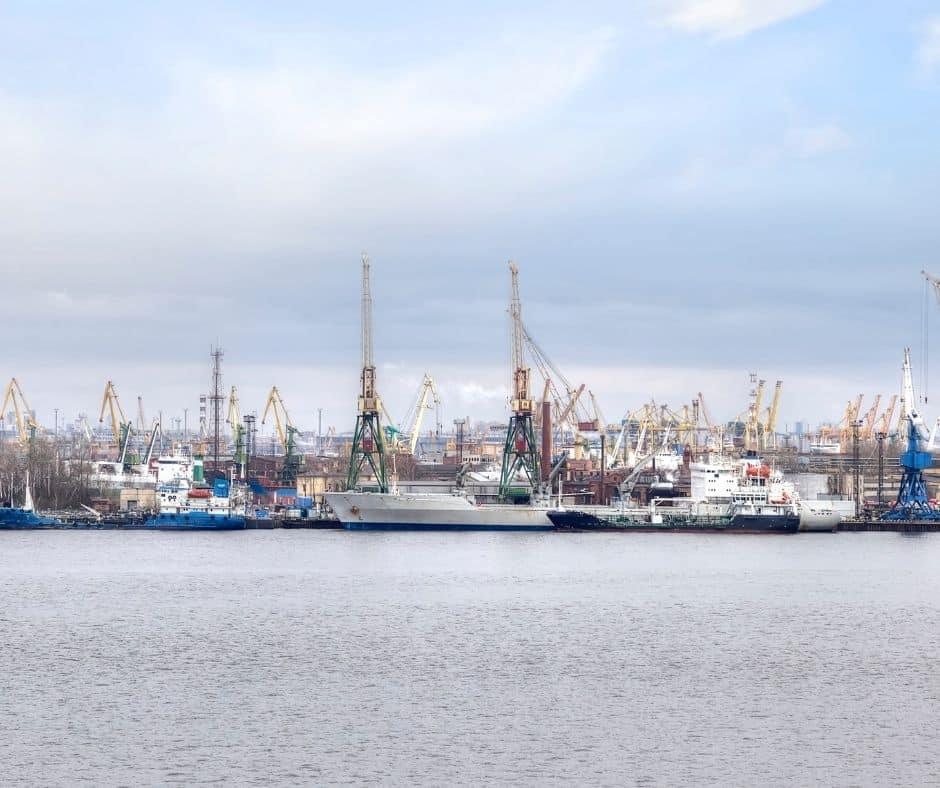
The Port of Saint Petersburg has one of the deepest drafts for any Russian facility. The inner anchorage ranges between 23 to 25 meters while the channel draft is approx. 18.5 to 23 meters.
As one of the major ports in Russia, its water area spreads over an expanse of 164 sq. km. Meanwhile, the beginning of its establishment dates back to 1869. At present, the facility uses 470 vessels for in-house operations along their coast.
The passenger terminal at St. Petersburg handles over 450 vessels annually. This happens over a dozen of berths, with 2 major terminals having the alongside the extent of 360 meters.
The total mooring size capacity of this facility is over 30 kilometres. This includes the working capacity of more than 200 berths of various sizes in this facility.
St. Petersburg famously works with 8 major cranes of Panamax capacity. This couples with 3 RMG and 20 gantry nature cranes for handling container goods. This rounds off to the port’s annual handling figures to well over 2 million every year.
The facility connects with major cargo shipping destinations through 2 dozen operating lines. It acts as the major gateway for providing shipping access to the Russian interiors. The neighbouring ports like Rotterdam, Bremerhaven, etc. act as the feeder terminals for the super container ships .
Over 122 tugs and 3 dozen oil barges are resident for berthing and bunkering operations. The rail line operates through the container segment of the port, handling container transport.
3. Port of Ust-Luga (Kingiseppsky District, Russia)
UN/Locode: RUULU Latitude: 59.68294° Longitude: 28.329515°
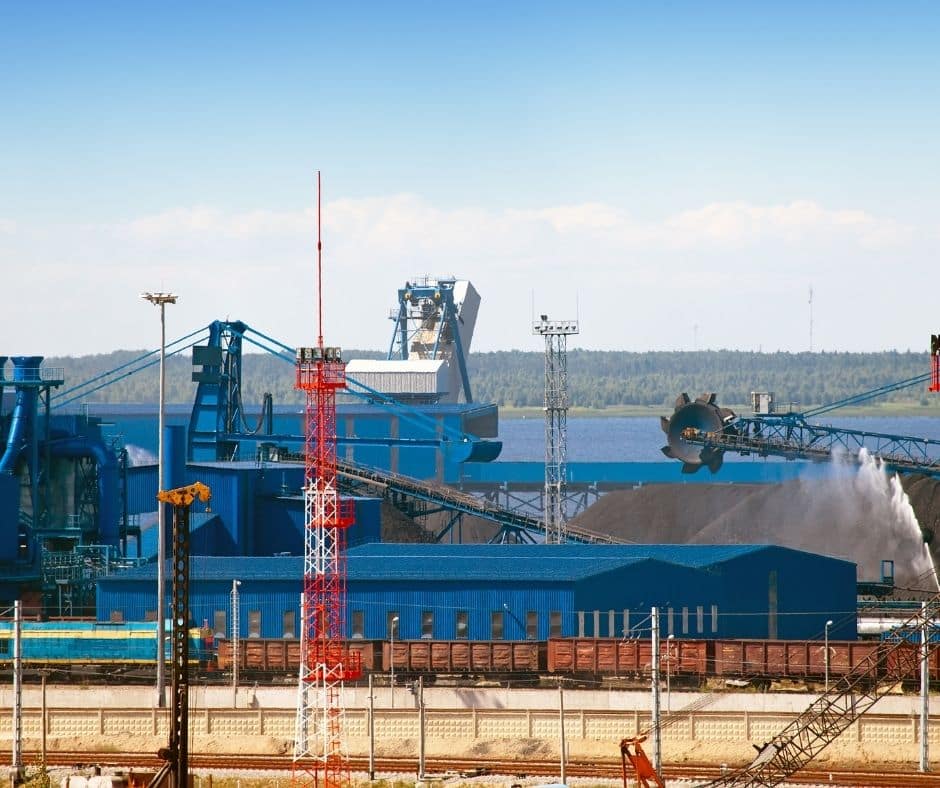
The port of Ust-Luga stands only behind Novorossiysk in terms of cargo handling volume for 2020. It has the biggest handling facility for coal bulk operations in the Northern part of Russia. The additional expansion plans provide this facility with a total area of 30 sq. km.
Ust-Luga has 5 major berths that operate for round the year operation in severe temperatures. These handle over 30 vessels at once with anchorage facilities over 20 meters and higher depth.
The state-of-art coal loading facilities handle export abilities up to 20 million MT annually. It also is one of the newest facilities in Russia, dating back to 2011 for its establishment.
The loading conveyors for the coal handle up to 500 MT every hour on average. This facility accommodates vessels ranging up to 60,000MT of DWT for coal loading.
In addition, Ust-Luga also handles livestock, liquid, and general cargo operations. The overall cargo operations have figures worth 102.6 million MT for 2020. 2 mega cranes of 104 MT capacity and 1 of 80 MT capacity operate simultaneously with the conveyor system.
The berthing network contains a ramp bridge terminal and 7 deep berths spread across 1500 meters. Their operations handle 1000 to 1450 vessels up to 1,20,000 MT DWT.
The layout also has a warehouse for final goods handling, spread over 2800 sq. meters. This facility connects with the Ust-Luga railway terminal that has a special station for the port. The plan is for expanding the facility for over 26 train arrivals every day in the next decade.
4. Port of Vostochny (Nakhodka Bay, Russia)
UN/Locode: RUVYP Latitude: 42.762495° Longitude: 133.0514°
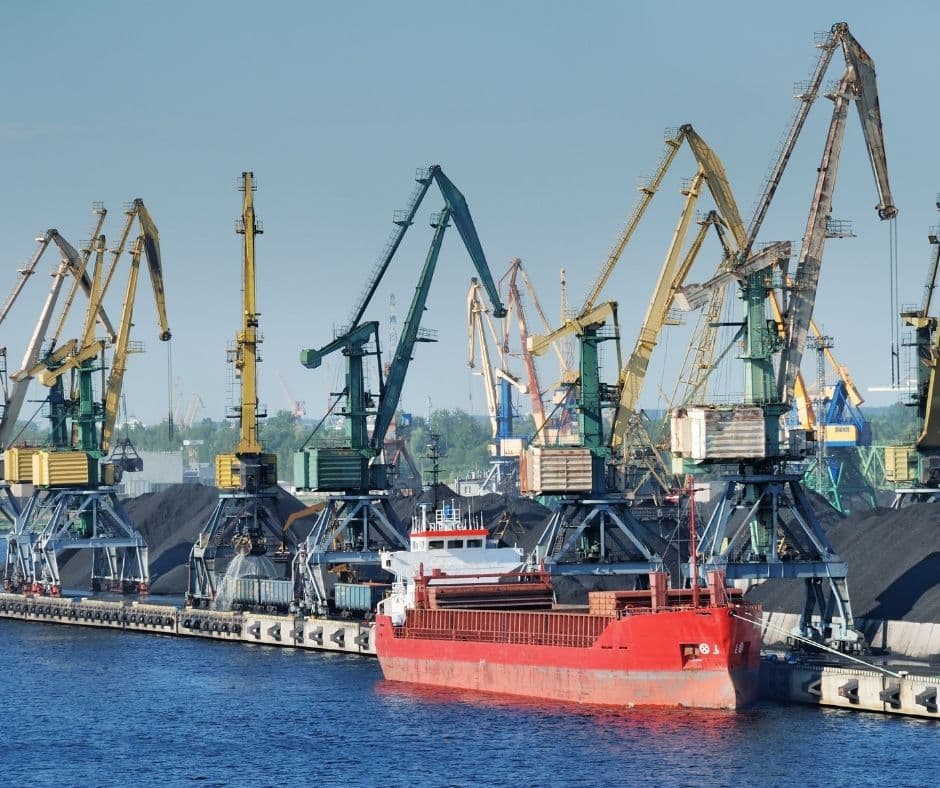
The port of Vostochny operates with two major terminals for a handling capacity of 80 million MT. In 2020, the facility shows stats worth 77 million MT including the export. In the internodal structure, the coal loading takes place at the special coal terminal.
The facility is amongst the oldest in the major ports in Russia, dating back to 1974. The trans-Siberian railway connects the terminal to the most prominent end-user plants. Vostochny’s major exports connect with the Asian countries, with Japan and Korea using up to 60%.
Over 550 vessel arrivals for the year 2019 have mostly bulk carriers of different sizes. The facility accommodates vessels up to 1,80,000 MT DWT for bulk coal operations.
The general handling facilities show 300,000 units of rail cars carrying the cargo for this period. The discharge to these rails uses the conveyor mechanism with automatic operations.
The Vostochny terminal employs over 1700 people for the cargo and operational routines. The spreading layout uses 98% of mechanical and electrical automation for operations.
With the progressive development of their phase 3, the handling capacities will touch over 100 million MT. As a result, the net income of the facility amounts to an annual figure of 125 million USD.
5. Port of Primorsk (Vyborgsky District, Russia)
UN/Locode: RUPRI Latitude: 60.3463° Longitude: 28.67096°
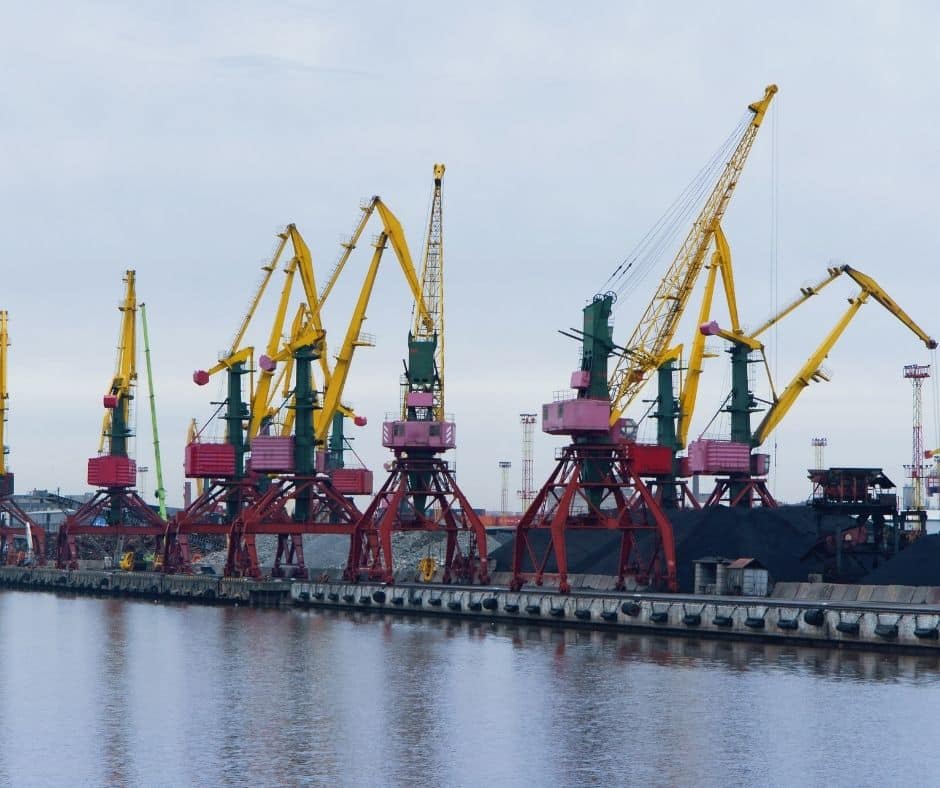
The Port of Primorsk is spread across a land piece of 5.4 sq. km area for cargo operation. This is in addition to the 32 sq. km of water limits within their expanse. It features amongst the top Russian ports by volume, handling 50 million MT+ cargo annually.
The initial operations at the facility date back to the year 2001, with a further increase in 2004. The facility operates 6 major berths that spread across a length of 2.8 km alongside. The deepest tanker-handling terminals allow drafts up to 17.8 meters for convenient loading.
An annual handling capacity of 60 million MT and more of liquid cargo allows major export relations. The Primorsk port also stands out as the highest contributor to oil exports in Russia.
The operations include 50 major oil extraction firms for direct loading transfers. All loading arms connect for a throughput of 2800 cubic meters loading rate for bigger tankers. This allows tankers of 1,50,000 DWT capacity to arrive with better draft features.
The wide oil handling range connects with the Baltic Pipeline and serves at its one end. This comes with a specific terminal for gas loading operations that operates 8-24hrs for cargo.
The 2 phases of pipeline extending onwards span over 1000 kilometres for oil handling. These terminals involve 250 regular employees with camera surveillance measures.
6. Port of Murmansk (Kola Bay, Russia)
UN/Locode: RUMMK Latitude: 68.984125° Longitude: 33.061°
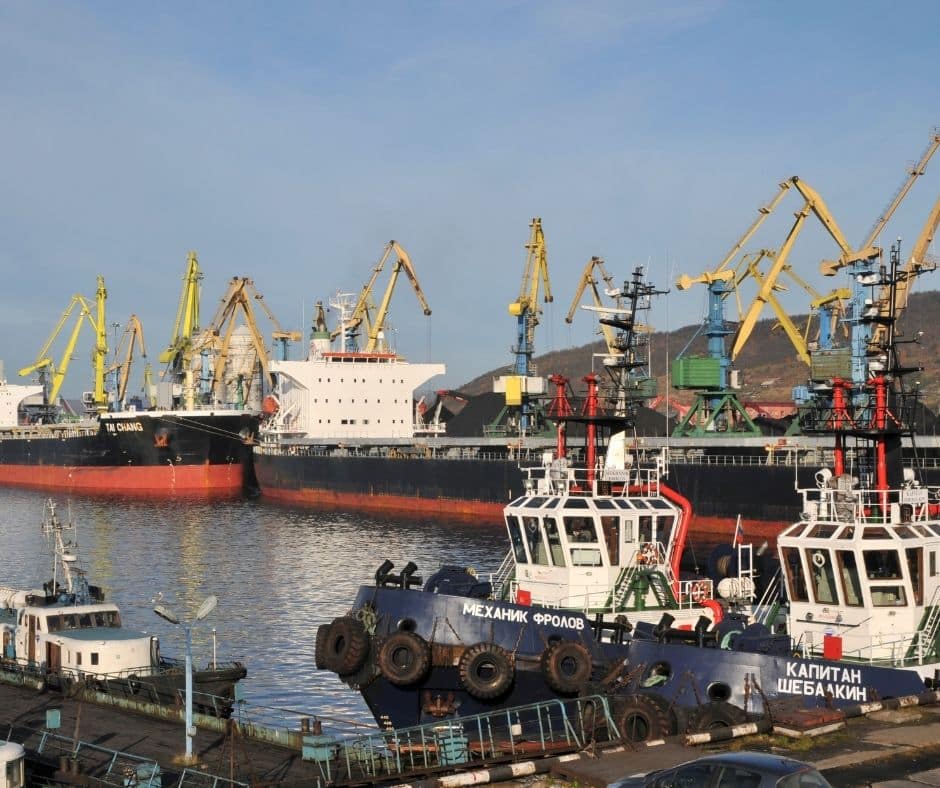
With its location on the northern end of the Arctic circle, Murmansk is the coldest Russian port. It also is the largest to lie on the North of this geography. It is also the geographical North-most amongst the major ports in Russia.
The port helps to house the ice-breaking vessels assisting the larger vessels passing through the Arctic. Its establishment owing to this reason is also quite old, dating back to 1917.
The port operates through its 15 berths, 11 of which are for solid cargo. These berths divide into 2 major port districts or nodes for operation. The general berths operate over 1.5 km in length, while the oil terminals operate on half the figure.
In 2021, Murmansk has figures worth 56 million MT of cargo through its facility. All major bulk cargo operations take place through the gantries at a steady rate. The operates to switch between 16 and 32 MT per hour operation capacity for these.
Meanwhile, the bulk liquid berths vary between 10 to 15 meters in depth. The 3 terminals that use the roadways facility operate the majority of bulk operations.
Despite its challenging location, Murmansk operates round the year. Its expanse has an additional third node for car and container handling tasks. It is the only node with length restrictions, with vessels coming up to 220 meters long.
Major bulk cargo storage facility houses more than 25000 MT in this area. The facility houses over 200 operators for cargo, and less than 100 for ice-breaking requirements.
7. Port of Vladivostok (Vladivostok, Russia)
UN/Locode: RUVVO Latitude: 43.087445° Longitude: 131.9022°
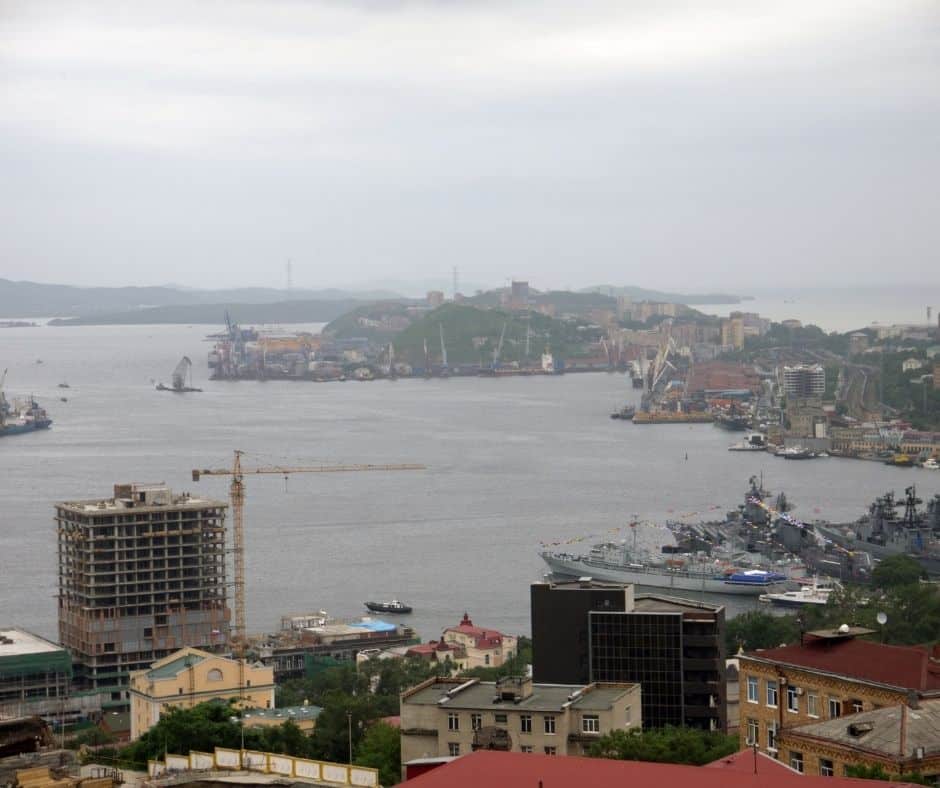
The port of Vladivostok provides Russia with an opportunity to explore the Pacific. It extends towards the south-eastern end and touches the Sea of Japan for the bulk Asian traffic. This facility spreads across 55 hectares and also provides a cultural significance for the Russian landmass.
Vladivostok has a record of handling 24 million MT of cargo for 2021. It is significantly higher than its 13.9 million MT average across the decade. The port’s establishment starts in the 1800s, with free status existence in between.
The terminal operates through its range of 15 berths for general operations. Each of these varies between 10 to 15 meters for depth. The approach through the channel gives a depth of up to 25 meters.
A collection of 200 automatic and semi-automatic loading resources are available overall. This includes the STS, RMG, and RTG facilities operating alongside. The container handling facilities operate round the year for efficient discharging.
Being the south-eastern tip, the Vladivostok network has major relation with Asian ports. 45% and more of their trade flow through Korea, Japan, and China in combination. The layout divides into the universal and the container-specific terminals for operation.
An area of 450,000 sq. meters is available for the warehouse storage and handling of goods. The inter-port handling facilities feature a train map and 2 major truck checkpoints.
Russian Shipping Riches
The sea transport shares a stake worth 112 087 million current USD for the Russian trade. This creates a significant impact for managing international trade, despite the large land area. The concentration of land does not have too big inland waterways, leading to major ocean ports.
Moreover, the testing conditions while operating in the Arctic do not make the cargo movement easier. In such situations, the Russian authorities focus highly on developing the ice-breaking fleet for year-long operations.
With a diverse portfolio, the major ports in Russia handle cargo of every significant use. The country’s latest focus on developing a green corridor is in line with the shipping requirement and future.
You might also like to read:
- 7 Major Ports of South Africa
- 7 Major Ports of the United States
- 7 Major Ports in The United Kingdom
- 10 Major Ports In Brazil
- Top 14 Major Ports in Italy
Disclaimer : The information contained in this website is for general information purposes only. While we endeavour to keep the information up to date and correct, we make no representations or warranties of any kind, express or implied, about the completeness, accuracy, reliability, suitability or availability with respect to the website or the information, products, services, or related graphics contained on the website for any purpose. Any reliance you place on such information is therefore strictly at your own risk.
In no event will we be liable for any loss or damage including without limitation, indirect or consequential loss or damage, or any loss or damage whatsoever arising from loss of data or profits arising out of, or in connection with, the use of this website.

Do you have info to share with us ? Suggest a correction

About Author
Saurabh Sinha is an active marine engineer, sailing with one of the leading shipping companies across the globe. A keen interest in exploring beautiful destinations across the globe and immortalising them in words motivates him for professional writing ventures. He values connecting with the readers and sharing his personal experiences.
Read More Articles By This Author >
Daily Maritime News, Straight To Your Inbox
Sign Up To Get Daily Newsletters
Join over 60k+ people who read our daily newsletters
By subscribing, you agree to our Privacy Policy and may receive occasional deal communications; you can unsubscribe anytime.

BE THE FIRST TO COMMENT
Leave a reply.
Your email address will not be published. Required fields are marked *
Subscribe to Marine Insight Daily Newsletter
" * " indicates required fields
Marine Engineering
Marine Engine Air Compressor Marine Boiler Oily Water Separator Marine Electrical Ship Generator Ship Stabilizer
Nautical Science
Mooring Bridge Watchkeeping Ship Manoeuvring Nautical Charts Anchoring Nautical Equipment Shipboard Guidelines
Explore
Free Maritime eBooks Premium Maritime eBooks Marine Safety Financial Planning Marine Careers Maritime Law Ship Dry Dock
Shipping News Maritime Reports Videos Maritime Piracy Offshore Safety Of Life At Sea (SOLAS) MARPOL
WAIT! Did You Download 13 FREE Maritime eBooks?
Sign-up and download instantly!
We respect your privacy and take protecting it very seriously. No spam!

The latest ITV News headlines - as man is charged with Bushey crossbow murders
More news videos.
Series 11 • BAFTA-nominated breakfast show covering the latest news, sport & weather
Series 9 • The latest news from ITV News at Ten
Series 9 • All the latest news from the ITV Evening News team
1h 15m • The story of the war in Gaza and the attacks on the 7th of October, 2023
Series 25, 26, 26 • Compelling current affairs stories that get to the heart of what matters
1h • Prince Harry, Hugh Grant & others open up about the hacking scandal
Series 10 • ITV News' Robert Peston presents his lively political interview programme
1h • Seven politicians go head to head in ITV's General Election debate
1h • Martin hosts a summer special packed with financial 'need to knows'
50m • Join the party leaders for in-depth interviews
1h 10m • The leaders go head to head in the first TV General Election debate
1h 20m • Witness the inside story of Theresa May's tumultuous premiership
40m • Travels across the UK to celebrate the Jewish festival of Passover
40m • Shehab Khan follows the holy month of Ramadan and sees how it's observed
1h • The former gymnasts & their powerful fight for justice
1h • Journalist Robert Moore lifts the lid on Donald Trump's latest comeback
1h 5m • Timely documentary about the history of a controversial NHS unit
Series 1 • Starmer's victory speech, the rise of Reform and more
Series 1 • Watch every moment of Prime Minister's Questions
From excitement to agony - here are the must-watch moments
30m • How a groundbreaking covert police operation caught a killer
Watch key moments as Reform UK secure several seats
The Labour leader vows to 'rebuild Britain'
Sir Ed Davey hails the Liberal Democrats' 'historic result'
Julie Etchingham hosts as the final, damning Grenfell Report is released
Rishi Sunak speaks outside No 10
Starmer speaks minutes after Labour wins General Election
Catch up on the results as big names are booted out
30m • The ITV News archives reveal the real-life stories behind 'Mr Bates vs The Post Office'.
1h • Compelling story of the children taken to Russia after war broke out

COMMENTS
Smooth, calm waters allow for more efficient travel, while rough seas can increase fuel use due to the additional power needed to maintain speed and stability. Estimating Yacht Fuel Consumption. While it's challenging to provide a one-size-fits-all answer due to the variables involved, we can offer some general guidelines. On average, a yacht ...
Fuel economy in boating refers to how efficiently a boat uses fuel, typically measured in GPH or MPG. Optimizing the trim of the boat can lead to better fuel economy. When a boat is properly trimmed, it reduces drag and allows the boat to move through the water with less effort and power. This efficiency translates into less fuel consumption ...
Normal conditions: 2,600 RPM produces 14 knots and burns 12 GPH = 1.2 nMPG. New conditions: 2,750 RPM produces 14 knots and burns 14 GPH = 1.0 nMPG. The extra friction has reduced fuel economy by 17%. Engine misalignment or a binding Cutlass bearing would impact fuel economy in this range.
Fuel prices can vary but typically costs between €0.80 and €1.30 per litre. Yacht charter, sales and management company West Nautical added: "Fuel costs should be at the top of any yacht owner and captain's minds for two reasons: to minimise costs as well as reduce the environmental impact of burning unnecessary fuel.
The Greenline Hybrid yacht line is currently available in eight different models, including the sleek NEO sports boat, the family cabin cruising 33, 39 and 40, and the 45 Fly, 48 Fly, 48 Coupe and the 65 OC. All of these models achieve industry leading fuel efficiency. Greenline 40 Hybrid Diesel-Electric Solar Power Boat.
Again, you can remove a lot of weight from the boat by lowering its level. 2. Bring the Boat on Plane, then Leave the Throttle Alone. As is true with cars, boats tend to burn less gas at slower speeds. Boats are different, however, in that most get the worst fuel economy just below planning speed and the best economy just above it.
3 hrs x 130 gph = 390 gallons. All that is left to do now is add up the total amount of fuel needed and multiply the number with the price per gallon. (7500+390) x $3,5 = $27615. In this example, the final cost of your will set you back a little bit more than 27 thousand dollars.
The Nordhavn 40 set the world record for a production boat under 70 feet, circumnavigating the globe 20 years ago. More than a stretched version of her famous little sister, the Nordhavn 41 is a full-displacement vessel with entirely new tooling. With a loyal, almost cult following of fuel-efficient mariners focused on a greener world, Nordhavn ...
Most yachts have fuel and water tanks that are much larger than what is needed for a day trip, so by keeping these tanks just full enough—plus some "just in case"—can also help your fuel economy. Diesel fuel weighs approximately 7 pounds per gallon, gasoline weighs 6 pounds per gallon, and fresh water 8.4 pounds per gallon.
Boat-Fuel-Economy / Fuel Consumption Charts & Calculator Outboard motors and Boat motors | Inboard: MerCruiser - Volvo Penta Diesel Marine engines | Outboard: Mercury ...
With knowledge of a boat's fuel economy-how much fuel the boat burns per mile or nautical mile of travel-boaters can estimate the range they can safely expect to run. Some boaters go as far as to develop a boat fuel consumption chart for their boat. You can use any Boating boat test as a model for this.
Apart from 15% more living space, the MJM 50z with 230 less HP has a 2 knot advantage in upper end cruising speed. At the same 25 knot cruise speed, the MJM burns half the fuel with a 200 mile greater range. 6. Triples are just as fuel efficient as twins. The MJM 50z with triple IPS 600s has marginally better fuel efficiency than that same MJM ...
Investing in quality marine fuel tanks, adopting innovative fuel-efficient practices, and properly servicing your engines regularly will all help to optimize your boat's fuel consumption. Whether going on a leisurely cruise or an extended expedition, take the helm with Yacht Management South Florida to optimize your journey today.
Fuel consumption calculator - MerCruiser - Cummins MerCruiser - Crusader - Volvo Penta Diesel - Mercury - Evinrude - Honda Marine - Yamaha Marine - Suzuki Marine - Tohatsu - Johnson - Outboards | GPH MPG LPH KPL
May 30, 2007. As gas prices soar, even this little can can cost a boater $24 to fill. High gas prices took some of the fun out of the Memorial Day weekend, which marks the beginning of the pleasure-boating season here in the Midwest. As gas approaches $4.00 per gallon, even owners of small runabouts are looking at a $150 bill for a fill-up.
Fuel consumption Chart - Mercury - Evinrude - Honda Marine - Yamaha Marine - Suzuki Marine - Johnson - Outboard Motors | MerCruiser - Volvo Penta Diesel Inboards | GPH MPG LPH KPL Miles per Gallon - Gallons per Hour | Kilometers per Liter - Liters per Hour. Outboard : Evinrude .
5 000 €. 10. Viking Yachts 42 Convertible - Most Fuel Efficient Cruiser Boats. This fuel-efficient express cruiser yacht is spacious and relaxing for family days on the water and serves as a great fishing boat. With this beautiful boat, you really can have it all.
The Triple E class is a family of very large container ships with a capacity of more than 18,000 TEUs, which are owned and operated by Maersk Line.. With a length of 399.2 m (1,309 ft 9 in), when they were built they were the largest container ships in the world, but were subsequently surpassed by larger ones such as CSCL Globe. [2] [3]In February and June 2011, Maersk Line awarded Daewoo ...
1 Motor Boat Charters and Rentals in Moscow available. Hire Motoryachts with captain/skipper only or charter crewed yachts in Moscow. Speedboats, power boats or luxury motor yachts READY TO BOOK ONLINE!
Boat Fuel Economy - Sea Ray Fuel Consumption / MPG calculator, GPH | Boat Models: Sundancer 230 - 240 - 250 - 255 - 260 - 265 - 270 - 280 - 300 - 305
Italian authorities in March impounded Russian coal and fertilisers magnate Andrey Melnichenko's $600mn Sailing Yacht A after Russia invaded Ukraine. Another yacht, the $300mn Philippe Starck ...
3. Port of Ust-Luga (Kingiseppsky District, Russia) UN/Locode: RUULU. Latitude: 59.68294°. Longitude: 28.329515°. The port of Ust-Luga stands only behind Novorossiysk in terms of cargo handling volume for 2020. It has the biggest handling facility for coal bulk operations in the Northern part of Russia.
Watch the latest from ITV News - Watch a short summary of the latest ITV News headlines.